An Equus-Dominated Middle Pleistocene (Irvingtonian) Vertebrate Fauna from Northcentral Florida, USA
Abstract
1. Introduction
2. Geographical and Geological Settings
| Locality | County | Site Code | Date | MSR | Subage | Map No. |
|---|---|---|---|---|---|---|
| McLeod Limerock Mine | Levy | LV003 | 1941 | 14 | Ir2 | 1 |
| Punta Gorda | Charlotte | CH002 | 1964 | 8 | Ir1 | 2 |
| Pool Branch Site | Polk | PO014 | 1964 | 13 | Ir1 | 3 |
| Coleman 2A | Sumter | SM001 | 1965 | 36 | Ir3 | 4 |
| Sebastian Canal | Brevard | BR009 | 1967 | 12 | Ir3 | 5 |
| Payne Creek Mine | Polk | PO069 | 1969 | 22 | Ir1 | 6 |
| Palmetto Mine | Polk | PO097 | 1969 | 22 | Ir1 | 6 |
| Crystal River Power Plant | Citrus | CI011 | 1969 | 16 | Ir1 | 7 |
| Haile 16A | Alachua | AL033 | 1973 | 33 | Ir1 | 8 |
| Leisey Shell Pit 2 | Hillsborough | HI010 | 1978 | 9 | Ir1 | 9 |
| Rigby Shell Pit | Sarasota | SA001 | 1982 | 12 | Ir1 | 10 |
| Phosphoria Mine | Polk | PO128 and PO131 | 1982 | 9 | Ir1 | 6 |
| Pareners Branch | Alachua | AL058 | 1982 | 10 | Ir1 | 11 |
| Leisey Shell Pit 1A | Hillsborough | HI007 | 1983 | 34 | Ir1 | 9 |
| Haile 21A | Alachua | AL043 | 1983 | 17 | Ir1 | 8 |
| Leisey Shell Pit 3A | Hillsborough | HI015 | 1986 | 17 | Ir1 | 9 |
| Leisey Shell Pit 3B | Hillsborough | HI019 | 1987 | 13 | Ir1 | 9 |
| Fort Green Mine | Hardee/Polk | PO094 and HR052 | 1988 | 9 | Ir1 | 6 |
| Tucker Borrow Pit | Brevard | BR011 | 1993 | 13 | Ir1 | 12 |
| Tri-Britton Site | Hendry | HN011 | 2001 | 18 | Ir3 | 13 |
| La Belle Highway Pit | Hendry | HN012 | 2001 | 16 | Ir3 | 14 |
| Dickerson Coquina Pit | St. Lucie | SL002 | 2002 | 16 | Ir3 | 15 |
| Haile 16B | Alachua | AL124 | 2005 | 9 | Ir1 | 8 |
| Steinhatchee River 2A | Dixie | DI012 | 2022 | 11 | Ir2 | 16 |

3. Materials and Methods
4. Results
Systematic Paleontology
5. Discussion
5.1. Biochronology of STR 2A
5.2. Significance of the Steinhatchee River 2A Local Fauna
Supplementary Materials
Author Contributions
Funding
Data Availability Statement
Acknowledgments
Conflicts of Interest
References
- Hay, O.P. The Pleistocene of North America and its vertebrated animals from the states east of the Mississippi River and from the Canadian provinces east of longitude 95°. Pub. Carnegie Inst. Wash. 1923, 322, 1–499. [Google Scholar]
- Simpson, G.G. The extinct land mammals of Florida. Ann. Rep. Florida Geol. Surv. 1929, 20, 229–279. [Google Scholar]
- Ray, C.E. A list, bibliography, and index of the fossil vertebrates of Florida. Spec. Pub. Florida Geol. Surv. 1957, 8, 1–174. [Google Scholar]
- Webb, S.D. Chronology of Florida Pleistocene mammals. In Pleistocene Mammals of Florida; Webb, S.D., Ed.; University Presses of Florida: Gainesville, FL, USA, 1974; pp. 5–31. [Google Scholar]
- Hulbert, R.C., Jr. The Fossil Vertebrates of Florida; University Presses of Florida: Gainesville, FL, USA, 2001; 384p. [Google Scholar]
- Uhen, M.D. A Review of North American Basilosauridae. Bull. Ala. Mus. Nat. Hist. 2013, 31, 1–45. [Google Scholar]
- Brown, R.C. Florida’s Fossils; Pineapple Press: Sarasota, FL, USA, 1988; 208p. [Google Scholar]
- MacFadden, B.J.; Morgan, G.S. New oreodont (Mammalia, Artiodactyla) from the late Oligocene (early Arikareean) of Florida. Bull. Am. Mus. Nat. Hist. 2003, 279, 368–396. [Google Scholar] [CrossRef]
- Domning, D.P. Fossil Sirenia of the West Atlantic and Caribbean Region. I. Metaxytherium floridanum Hay, 1922. J. Vert. Paleont. 1988, 8, 395–426. [Google Scholar] [CrossRef]
- Lyon, L.M.; Powell, C.; McDonald, H.G.; Gaudin, T.J. Premaxillae of the extinct megalonychid sloths Acratocnus, Neocnus, and Megalonyx, and their phylogenetic implications (Mammalia, Xenarthra). J. Mamm. Evol. 2015, 23, 121–132. [Google Scholar] [CrossRef]
- Emmert, L.G.; Short, R.A. Three new procyonids (Mammalia, Carnivora) from the Blancan of Florida. Bull. Fla. Mus. Nat. Hist. 2018, 55, 157–173. [Google Scholar] [CrossRef]
- Hulbert, R.C., Jr. A new early Pleistocene tapir (Mammalia: Perissodactyla) from Florida, with a review of Blancan tapirs from the state. Bull. Fla. Mus. Nat. Hist. 2010, 49, 67–126. [Google Scholar] [CrossRef]
- Kurtén, B. The Pleistocene Felidae of Florida. Bull. Fla. State Mus. 1965, 9, 215–273. [Google Scholar] [CrossRef]
- Savage, D.E. Late Cenozoic vertebrates of the San Francisco Bay region. Univ. Calif. Publ. Geol. Sci. 1951, 28, 215–314. [Google Scholar]
- Bell, C.J.; Lundelius, E.L.; Graham, R.W.; Barnosky, A.D.; Ruez, D.R.; Semken, H.A.; Webb, S.D.; Zakrzewski, R.J. The Blancan, Irvingtonian, and Rancholabrean Mammal Ages. In Late Cretaceous and Cenozoic Mammals of North America; Woodburne, M.O., Ed.; Columbia University Press: New York, NY, USA, 2005; pp. 232–314. [Google Scholar]
- Martin, R.A. Fossil mammals from the Coleman IIA Fauna, Sumter County. In Pleistocene Mammals of Florida; Webb, S.D., Ed.; University Presses of Florida: Gainesville, FL, USA, 1974; pp. 35–99. [Google Scholar]
- Webb, S.D.; Hulbert, R.C., Jr. Systematics and evolution of Pseudhipparion (Mammalia, Equidae) from the Late Neogene of the Gulf Coastal Plain and the Great Plains. In Vertebrates, Phylogeny, and Philosophy; Flanagan, K.M., Lillegraven, J.A., Eds.; University of Wyoming: Laramie, WY, USA, 1986; pp. 237–272. [Google Scholar]
- Webb, S.D.; Hulbert, R.C., Jr.; Morgan, G.S.; Evans, H.F. Terrestrial mammals of the Palmetto Fauna (early Pliocene, latest Hemphillian) from the Central Florida Phosphate District. Nat. Hist. Mus. Los Angel. Ctry. Sci. Ser. 2008, 41, 293–312. [Google Scholar]
- Morgan, G.S. Miocene and Pliocene marine mammal faunas from the Bone Valley Formation of Central Florida. In Contributions in Marine Mammal Paleontology Honoring Frank C. Whitmore, Jr.; Berta, A., Deméré, T.A., Eds.; San Diego Natural History Society: San Diego, CA, USA, 1994; pp. 239–268. [Google Scholar]
- White, T.E. An additional record of Megatherium from the Pliocene of Florida. Proc. N. Engl. Zool. Club 1941, 19, 3–6. [Google Scholar]
- Morgan, G.S.; Hulbert, R.C., Jr. Overview of the geology and vertebrate biochronology of the Leisey Shell Pit local fauna, Hillsborough County, Florida. Bull. Fla. Mus. Nat. Hist. 1995, 37, 1–92. [Google Scholar] [CrossRef]
- Frazier, M.K. New records of Neofiber leonardi (Rodentia: Cricetidae) and the paleoecology of the genus. J. Mammal. 1977, 58, 368–373. [Google Scholar] [CrossRef]
- Berta, A. The sabercat Smilodon gracilis from Florida and a discussion of its relationships (Mammalia, Felidae, Smilodontini). Bull. Fla. State Mus. 1987, 31, 1–63. [Google Scholar] [CrossRef]
- Hulbert, R.C., Jr.; Morgan, G.S. Quantitative and qualitative evolution in the giant armadillo Holmesina (Edentata: Pampatheriidae) in Florida. In Morphologic Change in Quaternary Mammals of North America; Martin, R.A., Barnosky, A.D., Eds.; Cambridge University Press: Cambridge, UK, 1993; pp. 134–177. [Google Scholar]
- Seymour, K.L. Size change in North American Quaternary jaguars. In Morphologic Change in Quaternary Mammals of North America; Martin, R.A., Barnosky, A.D., Eds.; Cambridge University Press: Cambridge, UK, 1993; pp. 343–372. [Google Scholar]
- Kurtén, B.; Anderson, E. Pleistocene Mammals of North America; Columbia University Press: New York, NY, USA, 1980; 442p. [Google Scholar]
- Savage, D.E.; Russell, D.E. Mammalian Paleofaunas of the World; Addison-Wesley: Reading, MA, USA, 1983; 432p. [Google Scholar]
- Webb, S.D.; Wilkins, K.T. Historical biogeography of Florida Pleistocene mammals. Spec. Pub. Carnegie Mus. Nat. Hist. 1984, 8, 370–383. [Google Scholar]
- Morgan, G.S.; Harris, A.R. Pliocene and Pleistocene vertebrates of New Mexico. New Mex. Mus. Nat. Hist. Sci. Bull. 2015, 68, 233–427. [Google Scholar]
- Boning, C.R. Florida’s Rivers, 2nd ed.; Pineapple Press: Sarasota, FL, USA, 2016; 254p, ISBN 978-1-56164-986-0. [Google Scholar]
- Lane, E. Karst in Florida. Spec. Pub. Fla. Geol. Surv. 1986, 29, 1–100. [Google Scholar]
- Upchurch, S.B.; Randazzo, A.F. Environmental geology of Florida. In The Geology of Florida; Randazzo, A.F., Jones, D.S., Eds.; University Press of Florida: Gainesville, FL, USA, 1997; pp. 217–249. [Google Scholar]
- Morgan, G.S.; Hulbert, R.C., Jr. Cenozoic vertebrate fossils from paleokarst deposits in Florida. In Caves and Karst of Florida; A Guidebook for the 2008 NSS National, Convention; Florea, L.J., Ed.; National Speleological Society: Huntsville, AL, USA, 2008; pp. 248–271. Available online: https://www.researchgate.net/publication/385442803_Cenozoic_Vertebrate_Fossils_from_Paleokarst_Deposits_in_Florida (accessed on 5 October 2024).
- Frailey, D. An early Miocene (Arikareean) fauna from northcentral Florida (the SB-1A local fauna). Occ. Pap. Mus. Nat. Hist. Univ. Kans. 1978, 75, 1–20. [Google Scholar]
- Frailey, C.D. The large mammals of the Buda local fauna (Arikareean: Alachua County, Florida). Bull. Fla. State Mus. 1979, 24, 123–173. [Google Scholar] [CrossRef]
- Hayes, F.G. The Brooksville 2 local fauna (Arikareean, latest Oligocene): Hernando County, Florida. Bull. Fla. Mus. Nat. Hist. 2000, 43, 1–47. [Google Scholar] [CrossRef]
- Morgan, G.S.; Czaplewski, N.J.; Simmons, N.B. A new mormoopid bat from the Oligocene (Whitneyan and early Arikareean) of Florida, and phylogenetic relationships of the major clades of Mormoopidae (Mammalia: Chiroptera). Bull. Am. Mus. Nat. Hist. 2019, 434, 1–141. [Google Scholar] [CrossRef]
- Simpson, G.G. Miocene land mammals from Florida. Bull. Fla. Geol. Surv. 1932, 10, 7–41. [Google Scholar]
- White, T.E. The lower Miocene mammal fauna of Florida. Bull. Mus. Comp. Zool. 1942, 92, 1–49. [Google Scholar]
- Pratt, A.E. Taphonomy of the microvertebrate fauna from the early Miocene Thomas Farm locality, Florida (U.S.A.). Palaeogeogr. Palaeoclim. Palaeoecol. 1989, 76, 125–151. [Google Scholar] [CrossRef]
- Auffenberg, W. The fossil snakes of Florida. Tulane Stud. Zool. 1963, 10, 131–216. [Google Scholar]
- Meylan, P.A. The squamate reptiles of the Inglis 1A Fauna (Irvingtonian: Citrus County, Florida). Bull. Fla. St. Mus. 1982, 27, 1–85. [Google Scholar]
- Emslie, S.D. Avian community, climate, and sea-level changes in the Plio-Pleistocene of the Florida Peninsula. Ornithol. Monogr. 1998, 50, 1–113. [Google Scholar] [CrossRef][Green Version]
- Gut, H.J. A Pleistocene vampire bat from Florida. J. Mammal. 1959, 40, 534–538. [Google Scholar] [CrossRef]
- Baskin, J.A. New procyonines from the Hemingfordian and Barstovian of the Gulf Coast and Nevada, including the first fossil record of the Potosini. Bull. Am. Mus. Nat. Hist. 2003, 279, 125–146. [Google Scholar] [CrossRef]
- Baskin, J.A. Additional carnivorans from the early Hemingfordian Miller Local Fauna, Florida. J. Vert. Paleont. 2017, 37, e1293069. [Google Scholar] [CrossRef]
- Becker, J.J. Fossil herons (Aves: Ardeidae) of the late Miocene and early Pliocene of Florida. J. Vert. Paleont. 1985, 5, 24–31. [Google Scholar] [CrossRef]
- Webb, S.D. Revision of the extinct Pseudoceratinae (Artiodactyla: Ruminantia: Gelocidae). Bull. Fla. Mus. Nat. Hist. 2008, 48, 17–58. [Google Scholar] [CrossRef]
- Ehret, D.J.; Bourque, J.R.; Hulbert, R.C., Jr. Terrapene putnami Hay, 1906 (Testudines, EMYDIDAE): Replacement of the holotype by designation of a neotype. Bull. Zool. Nomen. 2013, 70, 193–198. [Google Scholar] [CrossRef]
- Auffenberg, W. Fossil testudinine turtles of Florida. Genera Geochelone and Floridemys. Bull. Fla. State Mus. 1963, 7, 53–97. [Google Scholar] [CrossRef]
- Webb, S.D.; MacFadden, B.J.; Baskin, J.A. Geology and paleontology of the Love Bone Bed from the late Miocene of Florida. Am. J. Sci. 1981, 281, 513–544. [Google Scholar] [CrossRef]
- Bourque, J.R. A ptychogastrine (Testudines, Geoemydidae) from the early Miocene of Panama and a review of Miocene testudinoids from Central America. Bull. Fla. Mus. Nat. Hist. 2022, 59, 16–44. [Google Scholar] [CrossRef]
- Edmund, A.G. Evolution of the genus Holmesina (Pampatheriidae, Mammalia) in Florida, with remarks on taxonomy and distribution. Pearce-Sellards Ser. Tex. Mem. Mus. 1987, 45, 1–20. [Google Scholar]
- McDonald, H.G. Paleoecology of extinct Xenarthrans and the Great American Biotic Interchange. Bull. Fla. Mus. Nat. Hist. 2005, 45, 313–333. [Google Scholar]
- McDonald, H.G. Gravigrade xenarthrans from the early Pleistocene Leisey Shell Pit 1A, Hillsborough County, Florida. Bull. Fla. Mus. Nat. Hist. 1995, 37, 345–373. [Google Scholar] [CrossRef]
- Stock, C. Cenozoic Gravigrade Edentates of Western North America: With Special Reference to the Pleistocene Megalonychinae and Mylodontidae of Rancho La Brea; Carnegie Institution of Washington: Washington, DC, USA, 1925; 149p. [Google Scholar]
- Tedford, R.H.; Wang, X.-M.; Taylor, B.E. Phylogenetic systematics of the North American fossil Caninae (Carnivora: Canidae). Bull. Am. Mus. Nat. Hist. 2009, 325, 1–218. [Google Scholar] [CrossRef]
- Simpson, G.G. Pleistocene mammalian fauna of the Seminole Field, Pinellas County, Florida. Bull. Am. Mus. Nat. Hist. 1929, 56, 561–599. [Google Scholar]
- Arata, A.A. Revaluation of the Pleistocene Urocyon seminolensis from Florida. Quart. J. Fla. Acad. Sci. 1959, 22, 133. [Google Scholar]
- Berta, A. Fossil carnivores from the Leisey Shell Pits, Hillsborough County, Florida. Bull. Fla. Mus. Nat. Hist. 1995, 37, 463–499. [Google Scholar] [CrossRef]
- Hulbert, R.C., Jr. Late Miocene Tapirus (Mammalia, Perissodactyla) from Florida, with description of a new species, Tapirus webbi. Bull. Fla. Mus. Nat. Hist. 2005, 45, 465–494. Available online: https://www.floridamuseum.ufl.edu/wp-content/uploads/sites/35/2017/03/bulletin-hulbertlowres.pdf (accessed on 5 October 2024).
- Ray, C.E. Tapirus copei in the Pleistocene of Florida. Quart. J. Fla. Acad. Sci. 1964, 27, 59–66. [Google Scholar]
- Hulbert, R.C., Jr.; Wallace, S.C.; Klippel, W.E.; Parmalee, P.W. Cranial morphology and systematics of an extraordinary sample of the late Neogene dwarf tapir, Tapirus polkensis (Olsen). J. Paleont. 2009, 83, 238–262. [Google Scholar] [CrossRef]
- Ray, C.; Sanders, A.E. Pleistocene tapirs in the eastern United States. Spec. Pub. Carnegie Mus. Nat. Hist. 1984, 8, 283–315. [Google Scholar]
- Hulbert, R.C., Jr. Tapirus veroensis Sellards, 1918. Foss. Species Fla. 2003, 2, 1–14. [Google Scholar]
- Hulbert, R.C., Jr. The giant tapir, Tapirus haysii, from Leisey Shell Pit 1A and other Florida Irvingtonian localities. Bull. Fla. Mus. Nat. Hist. 1995, 37, 515–551. [Google Scholar]
- Leidy, J. Description of vertebrate remains from Peace Creek, Florida. Trans. Wagner Free Inst. Sci. 1889, 2, 19–31. [Google Scholar]
- Sellards, E.H. The skull of a Pleistocene tapir including description of a new species and a note on the associated fauna and flora. Ann. Rep. Fla. Geol. Surv. 1918, 10, 57–70. [Google Scholar]
- Lundelius, E.L.; Slaughter, B.H. Notes on American Pleistocene tapirs. In Athlon: Essays in Paleobiology in Honour of Loris Shano Russell; Churcher, C.S., Ed.; Royal Ontario Museum: Toronto, ON, Canada, 1976; pp. 226–243. [Google Scholar]
- Kohn, M.J.; McKay, M.P.; Knight, J.L. Dining in the Pleistocene—Who’s on the menu? Geology 2005, 33, 649–652. [Google Scholar] [CrossRef]
- Albright III, L.B.; Sanders, A.E.; Weems, R.E.; Cicimurri, D.J.; Knight, J.L. Cenozoic vertebrate biostratigraphy of South Carolina, U.S.A., and additions to the fauna. Bull. Fla. Mus. Nat. Hist. 2019, 57, 77–236. [Google Scholar] [CrossRef]
- Hulbert, R.C., Jr. Equus from Leisey Shell Pit 1A and other Irvingtonian localities from Florida. Bull. Fla. Mus. Nat. Hist. 1995, 37, 553–602. [Google Scholar] [CrossRef]
- Eisenmann, V.; Alberdi, M.T.; De Giuli, C.; Staesche, U. Methodology. In Studying Fossil Horses; Woodburne, M., Sondaar, P., Eds.; E.J. Brill: Leiden, The Netherlands, 1988; Volume 1, pp. 1–71. [Google Scholar]
- Webb, S.D. Pleistocene llamas of Florida, with a brief review of the Lamini. In Pleistocene Mammals of Florida; Webb, S.D., Ed.; University Presses of Florida: Gainesville, FL, USA, 1974; pp. 170–213. [Google Scholar]
- Webb, S.D.; Stehli, F.G. Selenodont artiodactyls (Camelidae and Cervidae) from the Leisey Shell Pits, Hillsborough County, Florida. Bull. Florida Mus. Nat. Hist. 1995, 37, 621–643. [Google Scholar] [CrossRef]
- Meachen, J.A. A new species of Hemiauchenia (Artiodactyla, Camelidae) from the late Blancan of Florida. Bull. Fla. Mus. Nat. Hist. 2005, 45, 435–447. [Google Scholar] [CrossRef]
- Ruez, D.R. Earliest record of Palaeolama (Mammalia, Camelidae) with comments on “Palaeolama” guanajuatensis. J. Vert. Paleont. 2005, 25, 741–744. [Google Scholar] [CrossRef]
- Webb, S.D.; Dudley, J. 1995. Proboscidea from the Leisey Shell Pits, Hillsborough County, Florida. Bull. Fla. Mus. Nat. Hist. 1995, 37, 645–660. [Google Scholar]
- Lucas, S.G. The last North American gomphotheres. In Late Cenozoic Vertebrate Paleontology: Tribute to Arthur H. Harris; Morgan, G.S., Ed.; New Mexico Museum of Natural History and Science: Albuquerque, NM, USA, 2022; pp. 45–58. [Google Scholar]
- Prado, J.L.; Alberdi, M.T.; Azanza, B.; Sánchez, B.; Frassinetti, D. The Pleistocene Gomphotheriidae (Proboscidea) from South America. Quat. Internat. 2005, 126–128, 21–30. [Google Scholar] [CrossRef]
- Lister, A.M. On the type material and evolution of North American mammoths. Quat. Internat. 2017, 443, 14–31. [Google Scholar] [CrossRef]
- Maglio, V.J. Origin and evolution of the Elephantidae. Trans. Am. Philos. Soc. New Ser. 1973, 63, 1–149. [Google Scholar] [CrossRef]
- Olsen, S.J. Osteology for the Archaeologist. Number 3. The American Mastodon and the Woolly Mammoth. Pap. Peabody Mus. Archaeol. Ethnol. 1972, 56, 1–47. [Google Scholar]
- McDonald, H.G. Osteology of the Extinct Gravigrade Edentate, Megalonyx, with Observations on Its Ontogeny, Phylogeny, and Functional Anatomy. Master’s. Thesis, University of Florida, Gainesville, FL, USA, 1977. [Google Scholar]
- Downing, K.F.; White, R.S. The cingulates (Xenarthra) of the Leisey Shell Pit Local Fauna (Irvingtonian), Hillsborough County, Florida. Bull. Fla. Mus. Nat. Hist. 1995, 37, 375–396. [Google Scholar]
- De Iuliis, G.; Cartelle, C. A new giant megatheriine ground sloth (Mammalia: Xenarthra: Megatheriidae) from the late Blancan to early Irvingtonian of Florida. Zool. J. Linn. Soc. 1999, 127, 495–515. [Google Scholar] [CrossRef]
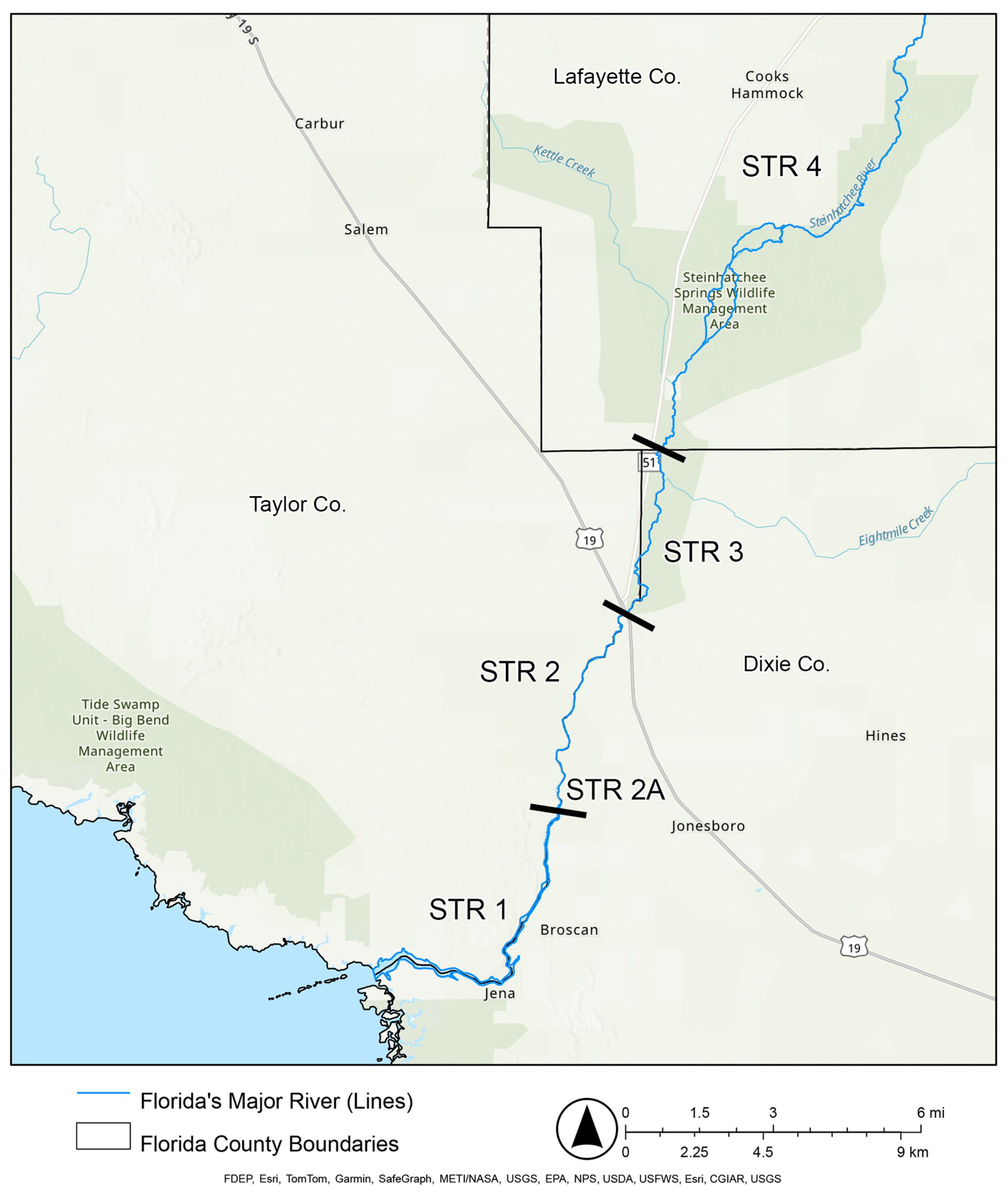

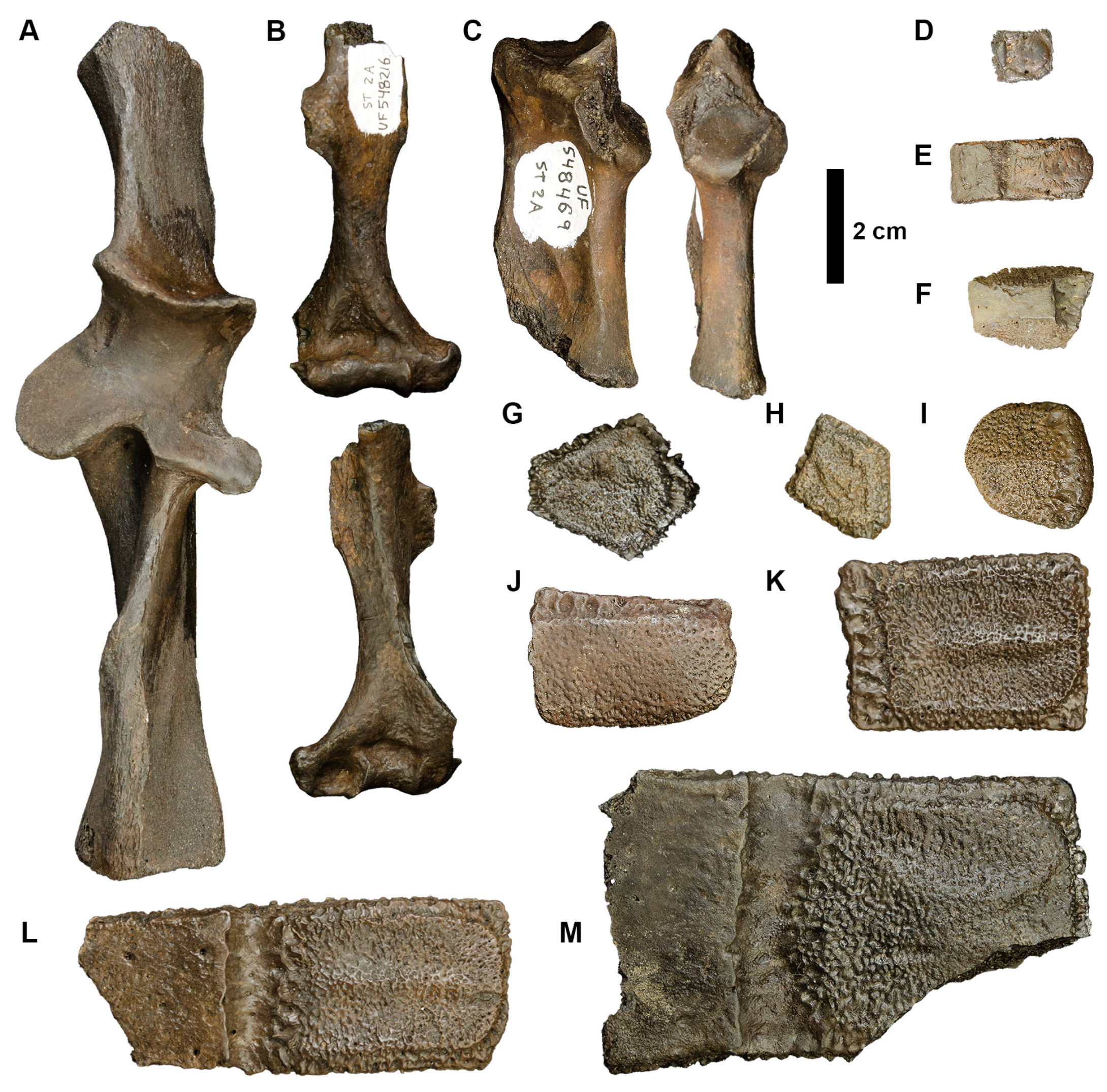

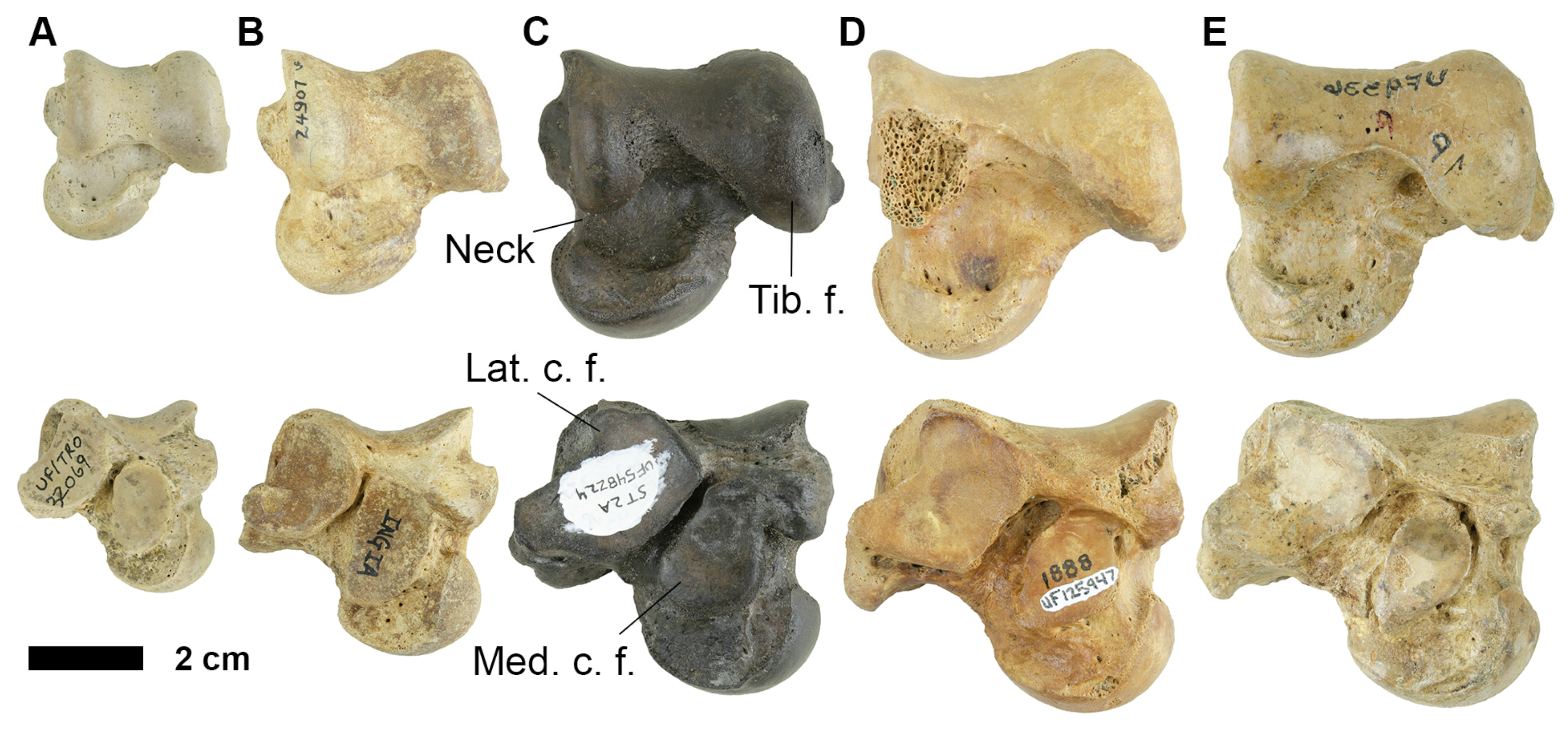
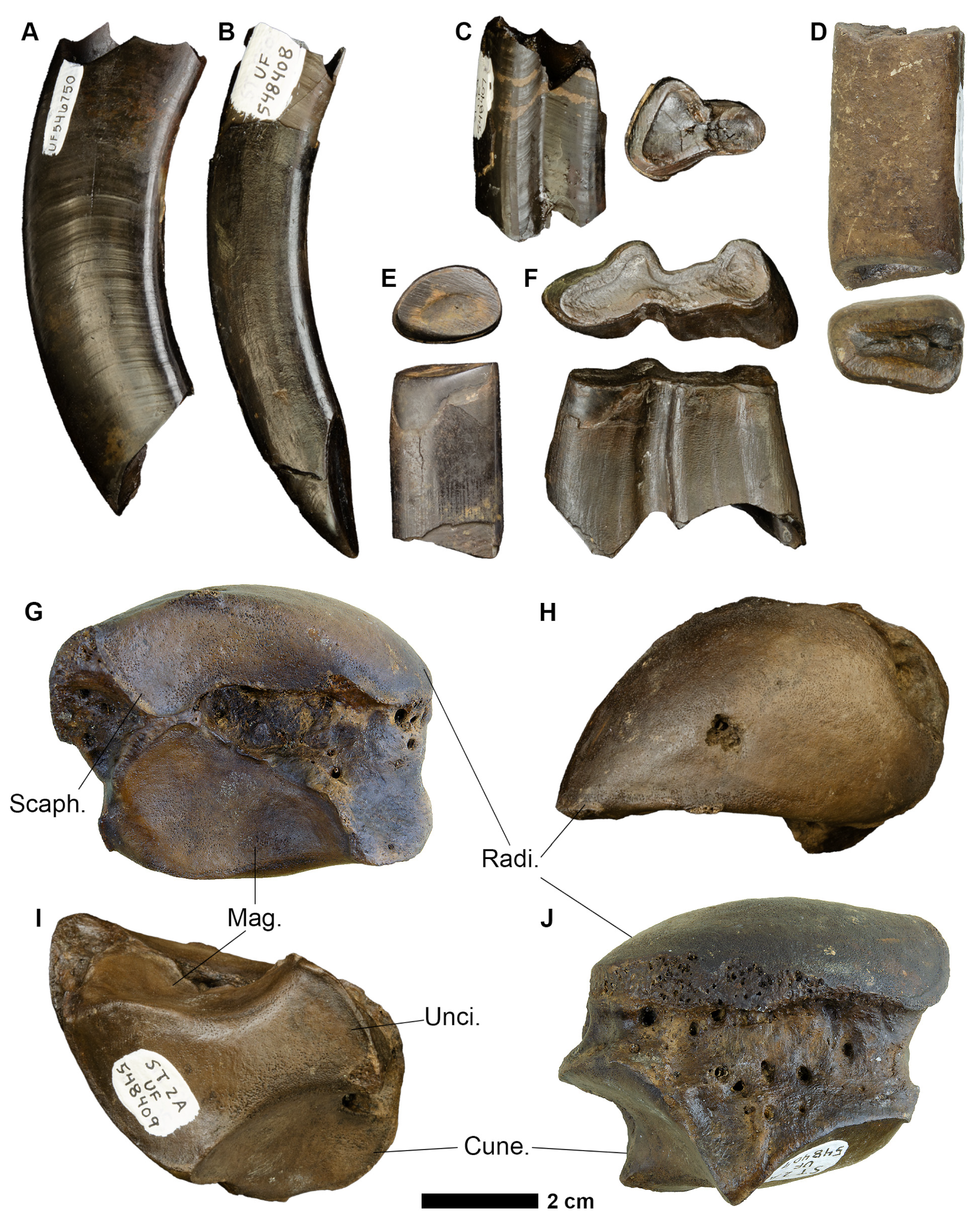

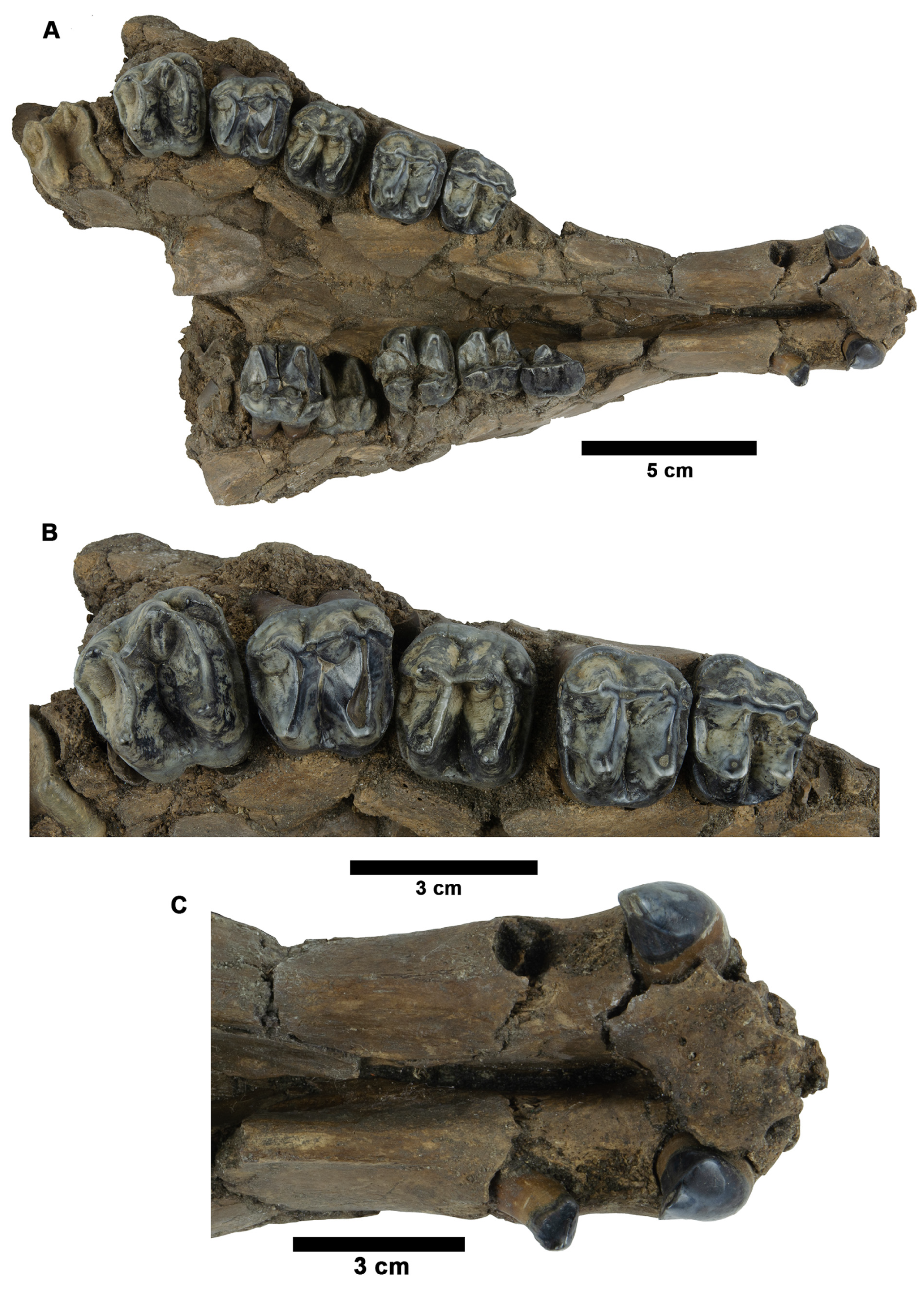
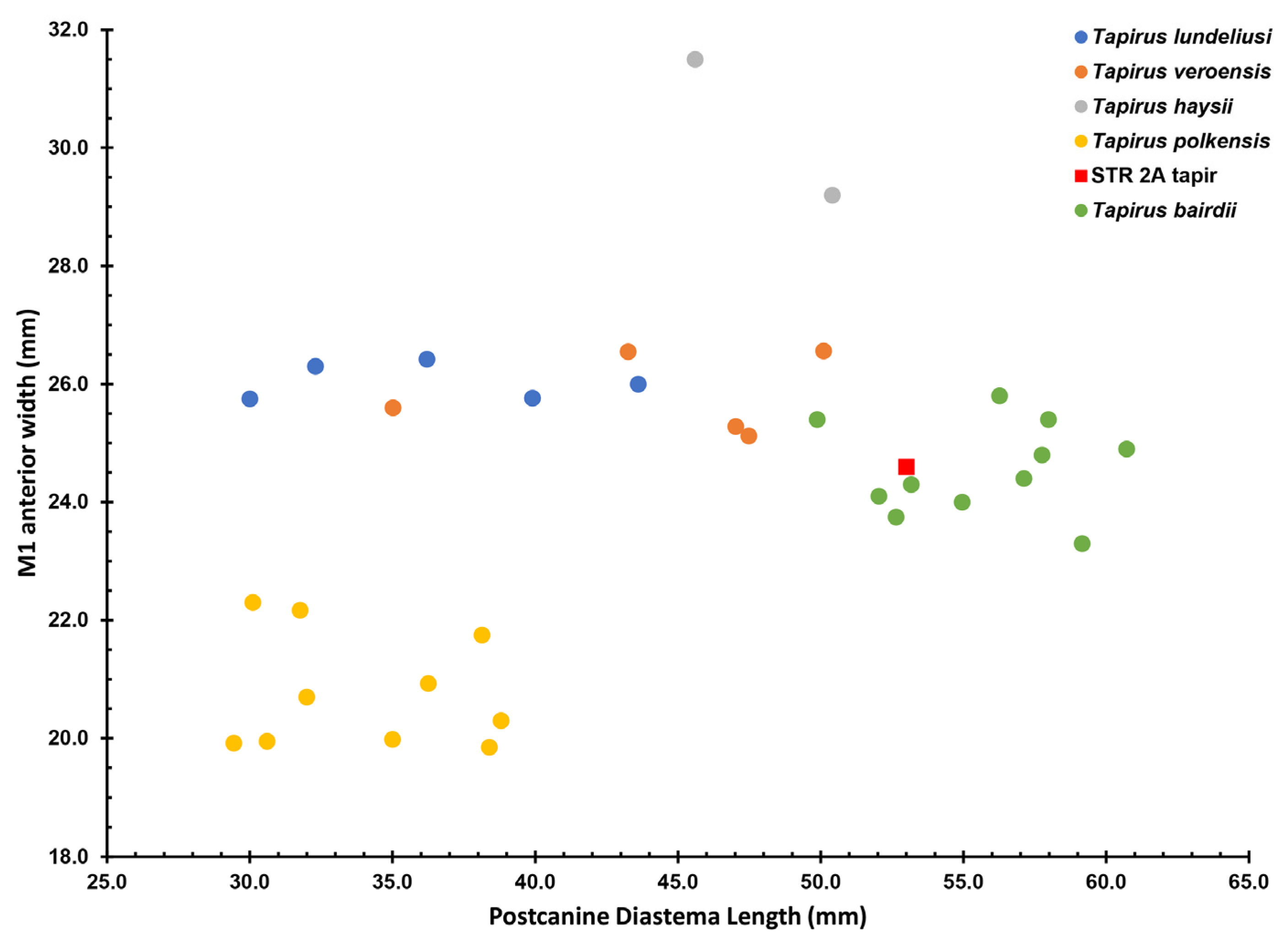
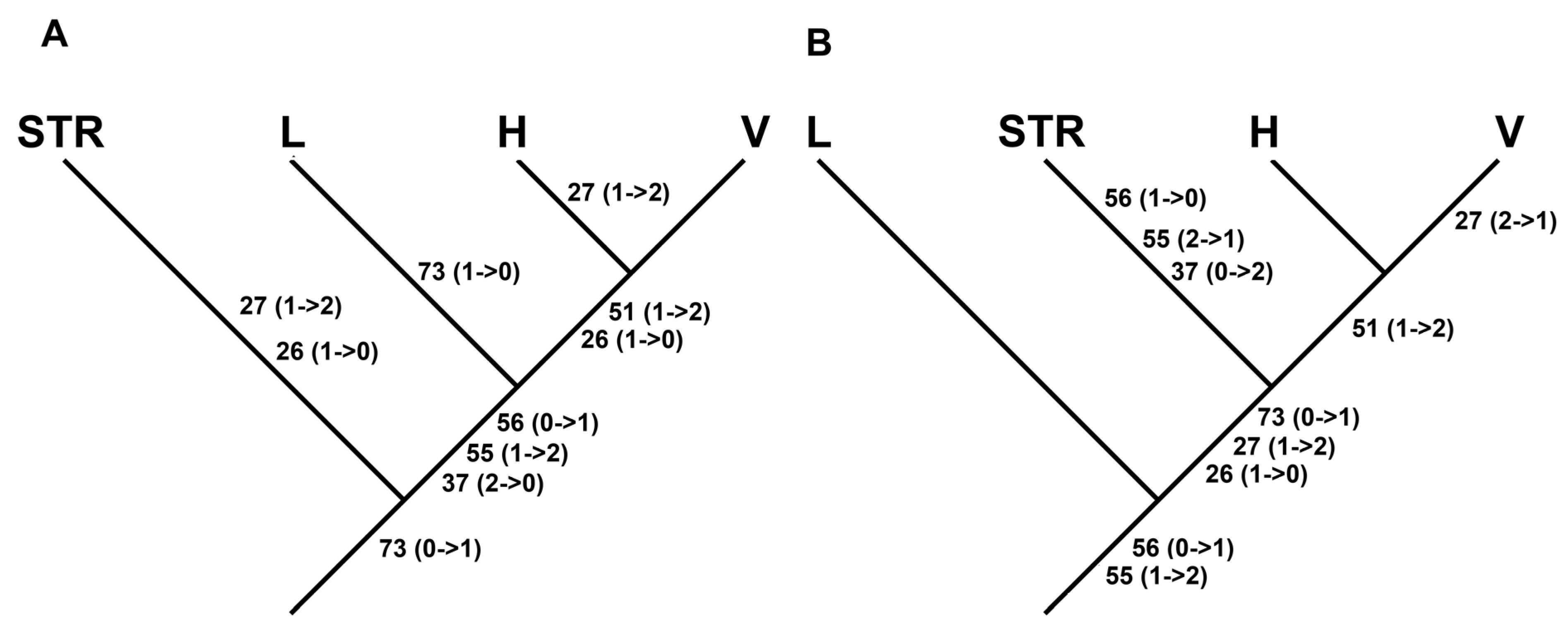


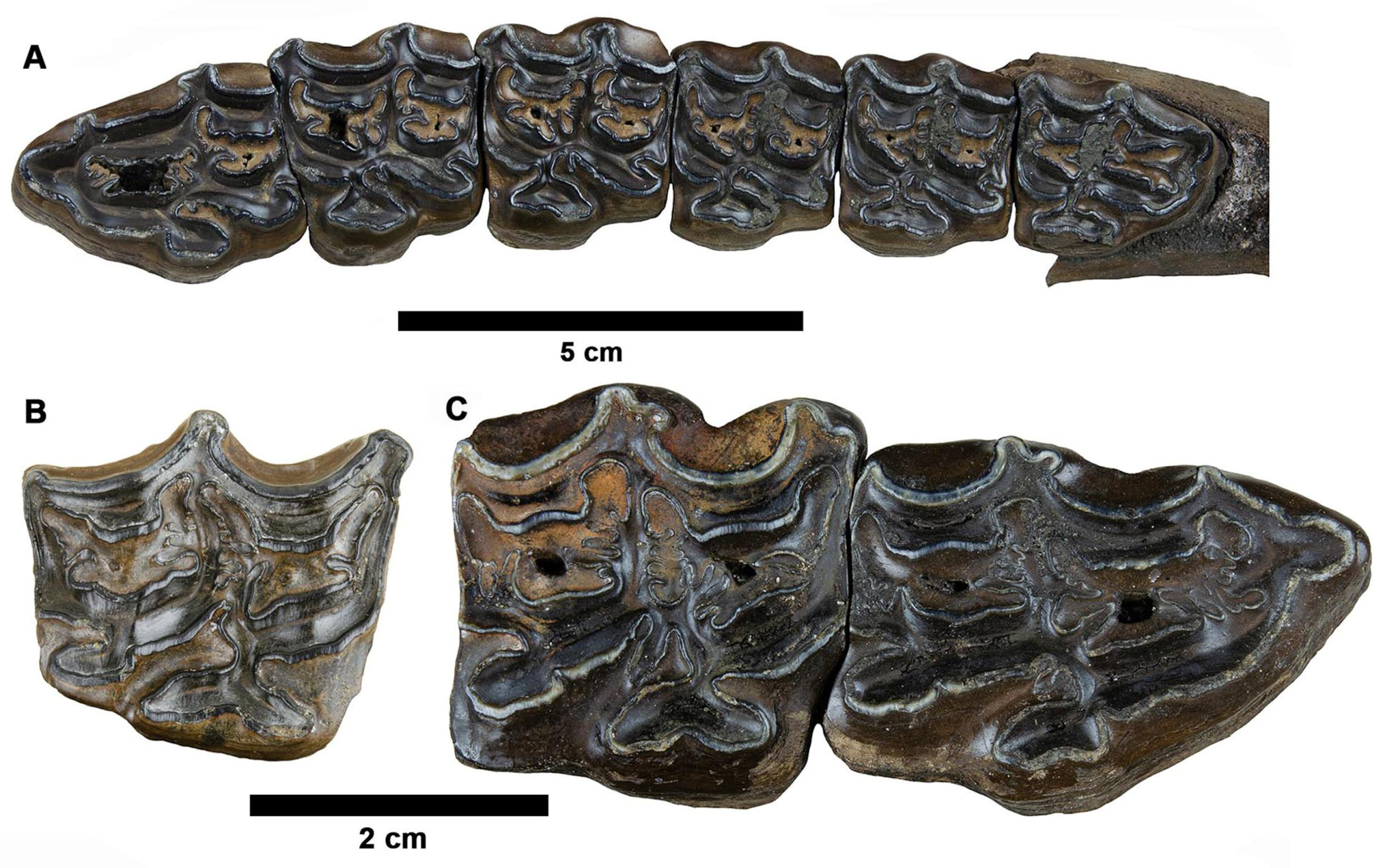
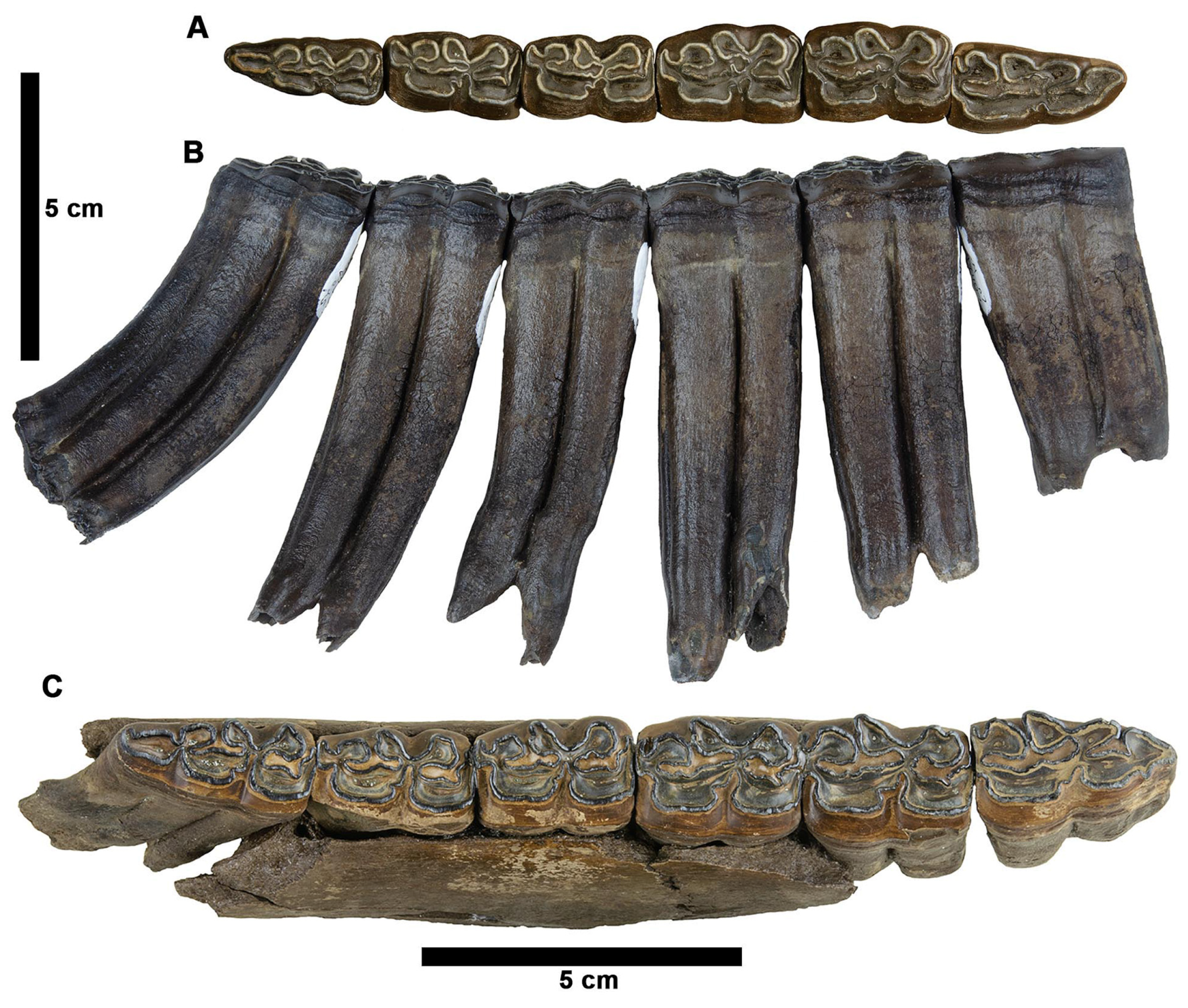
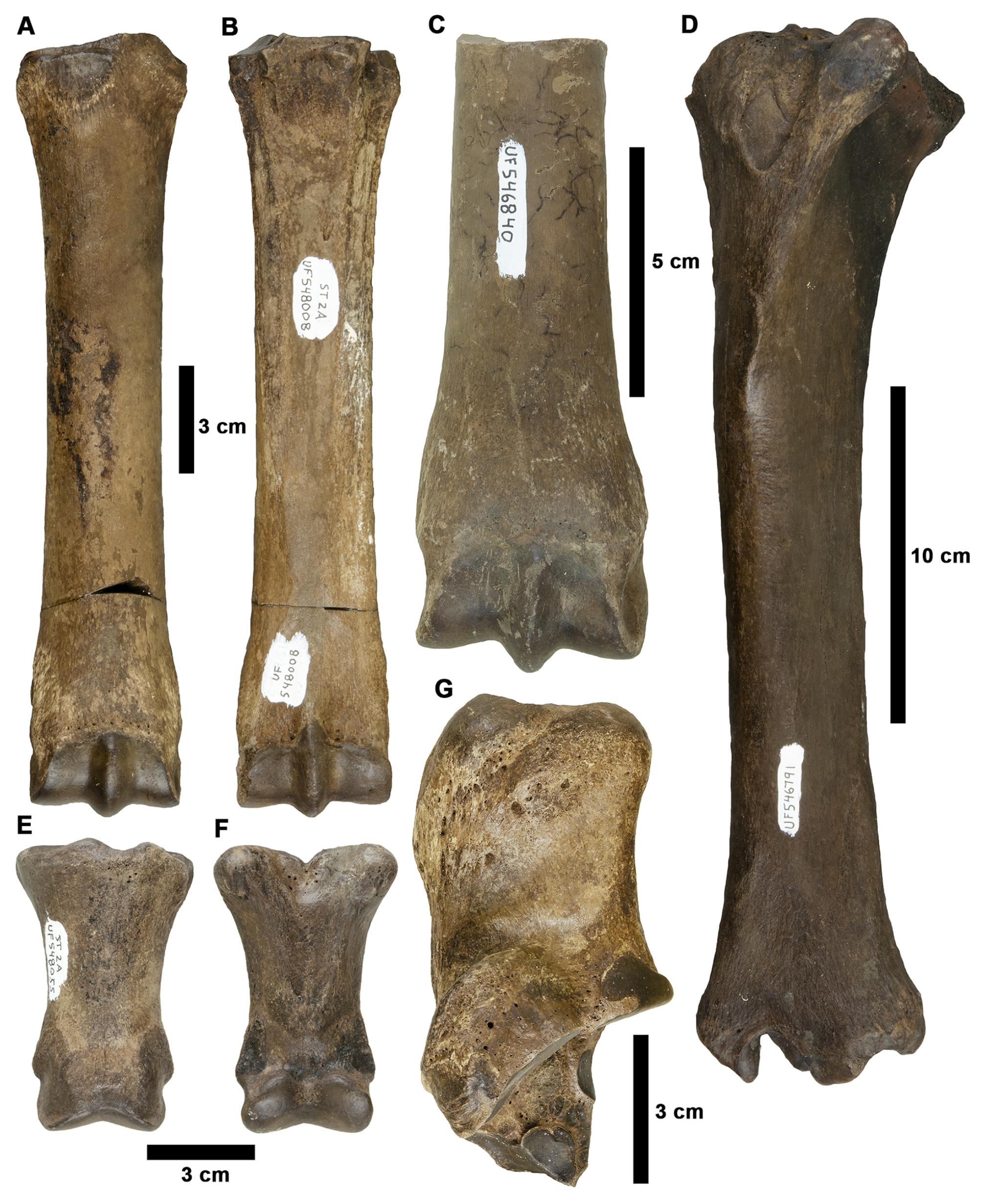


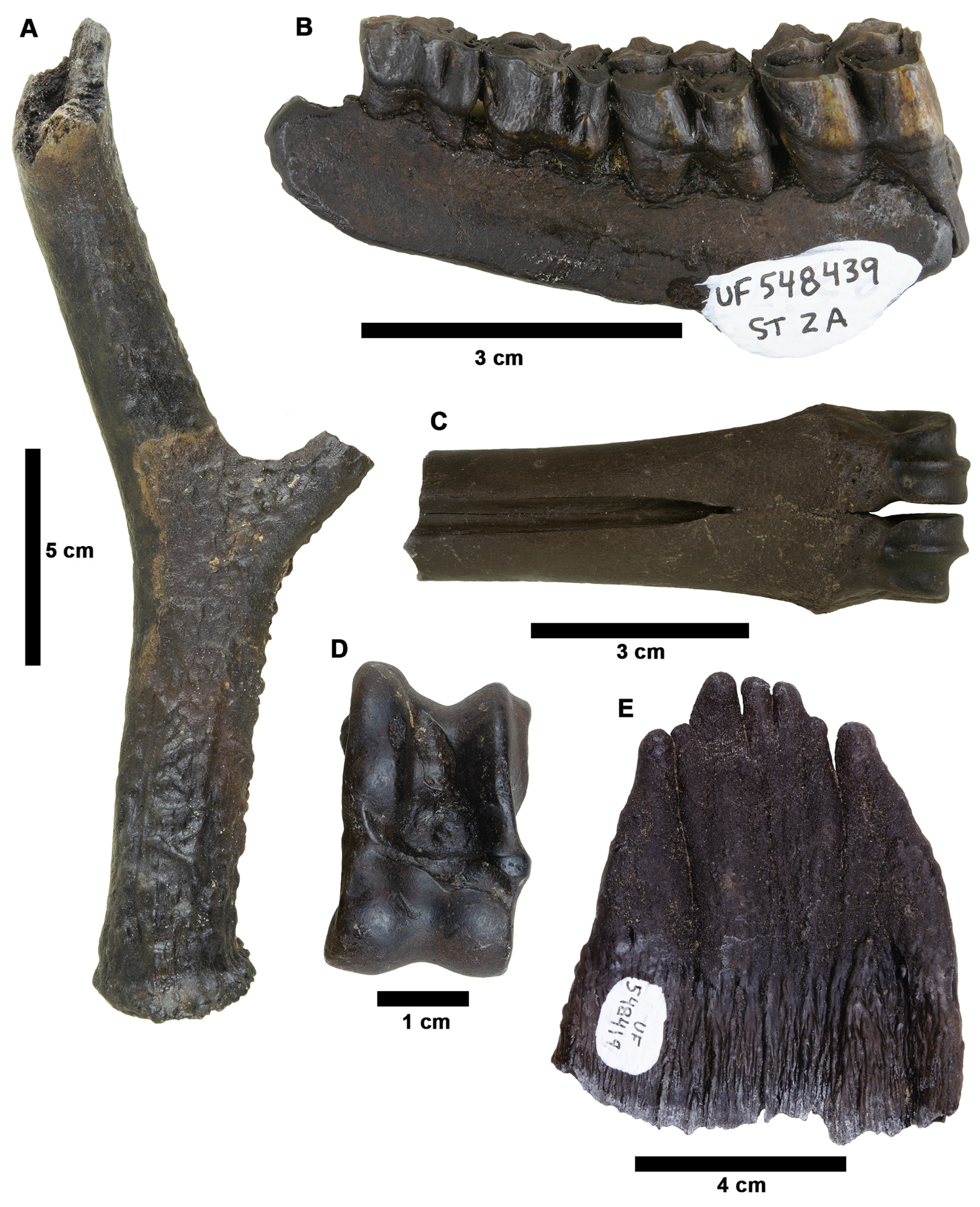
| Measurement | H. floridanus | UF/VP 548224 | H. septentrionalis |
|---|---|---|---|
| Greatest length, observed range (OR) | 30.5–44.8 | 50.4 | 45.4–54.4 |
| Proximal articular width, (OR) | 24.4–38.8 | 43.5 | 42.0–53.0 |
| Depth of tibial facet, medial side, (OR) | 17.4–27.8 | 28.9 | 25.1–32.1 |
| Distal articular width, (OR) | 17.4–26.1 | 30.1 | 27.3–31.7 |
| Width of astragular neck range (mm) | 15.8–26.7 | 27.3 | 28.1–34.8 |
| Greatest diameter of lateral calcaneal facet, (OR) | 13.7–24.5 | 30.6 | 27.2–32.3 |
| Greatest diameter of medial calcaneal facet, (OR) | 11.7–20.6 | 24.3 | 17.1–24.7 |
| Minimum distance between calcaneal facets, (OR) | 0–3.7 | 1.9 | 1.85–6.1 |
| Ratio of gr. diameters of medial and lateral facets, median | 84.9% | 79.5% | 72.6% |
| Measurement | Blancan | Irvingtonian | UF/VP 548409 | Rancholabrean |
|---|---|---|---|---|
| Maximum length of radial condyle, OR | 42.9–58.9 | 59.2–66.0 | 73.6 | 71.0–72.4 |
| Maximum height of facet for articulation with unciform, OR | 30.3–39.9 | 43.4–49.3 | 50.8 | 50.1–62.6 |
| Maximum width of combined facets for articulation with scaphoid and magnum, OR | 39.1–46.0 | 39.3–50.9 | 52.3 | 59.6–60.0 |
| Average volume of combined maximum measurements (mm3) | 85,156 | 135,303 | 195,490 | 241,312 |
| Minimum distance between facets for articulation with the scaphoid and magnum, OR | 4.9–6.3 | 0–7.4 | 1.6 | 4.0–6.6 |
| Catalog Number | Maximum Distal Width | Maximum Distal Depth |
|---|---|---|
| UF/VP 548427 | 13.7 | 9.6 |
| UF/VP 559671 | 14.2 | 8.7 |
| UF/VP 559672 | 13.9 | 9.1 |
| UF/VP 559673 | 13.8 | 9.2 |
| UF/VP 559674 | 13.1 | 8.3 |
| UF/VP 559675 | 13.7 | 9.2 |
| UF/VP 559676 | 14.3 | 9.8 |
| UF/VP 559677 | 12.9 | 8.7 |
| UF/VP 559678 | 14.3 | 9.5 |
| UF/VP 559679 | 13.8 | 9.1 |
| UF/VP 559680 | 13.7 | 9.0 |
| UF/VP 559681 | 12.5 | 8.5 |
| UF/VP 559682 | 13.3 | 8.8 |
| UF/VP 559683 | 14.0 | 9.3 |
| UF/VP 559684 | 13.2 | 9.4 |
| UF/VP 559685 | 12.6 | 8.8 |
| Mean | 13.55 | 9.03 |
| Standard Dev. | 0.59 | 0.40 |
| CV | 4.35 | 4.42 |
| Tooth ID | UF/VP 553071 Left Side | UF/VP 553071 Right Side | Tapirus veroensis | Tapirus lundeliusi | Tapirus haysii | Tapirus polkensis |
|---|---|---|---|---|---|---|
| P1 L | 17.8 | 18.70 ± 1.08, 45 15.7–20.6 | 18.56 ± 0.86, 16 17.0–19.8 | 21.19 ± 1.35, 7 19.7–23.3 | 14.39 ± 0.92, 30 12.3–16.5 | |
| P2 L | 19.4 | 19.74 ± 1.02, 4 16.7–21.9 | 19.44 ± 0.84, 18 18.0–21.6 | 22.07 ± 1.20, 10 20.6–24.3 | 15.39 ± 0.67, 35 14.0–17.0 | |
| P2 AW | 20.5 | 21.17 ± 1.18, 46 17.2–23.3 | 21.45 ± 0.90, 18 19.7–22.9 | 23.87 ± 1.14, 11 22.0–25.4 | 16.78 ± 0.97, 36 15.1–19.1 | |
| P2 PW | 22.6 | 23.40 ± 1.24, 42 21.1–25.8 | 23.51 ± 0.87, 18 22.2–25.1 | 26.23 ± 1.39, 11 23.8–28.0 | 18.98 ± 0.72, 35 17.8–20.8 | |
| P3 L | 19.9 | 20.31 ± 1.10, 43 17.4–22.6 | 19.97 ± 0.55, 18 18.6–21.6 | 22.89 ± 1.08, 11 21.6–24.5 | 16.09 ± 0.64, 38 14.5–17.0 | |
| P3 AW | 22.6 | 24.55 ± 1.22, 42 21.5–26.6 | 24.64 ± 0.77, 15 23.7–26.1 | 27.26 ± 1.01, 11 25.7–29.0 | 20.36 ± 1.00, 35 16.6–22.0 | |
| P3 PW | 23.6 | 24.52 ± 1.20, 40 22.1–26.7 | 24.08 ± 0.89, 16 22.7–25.7 | 26.96 ± 1.20, 12 25.4–29.3 | 20.04 ± 0.75, 36 18.5–21.9 | |
| P4 L | 21.0 | 21.63 ± 1.21, 52 18.7–23.6 | 21.25 ± 0.73, 18 19.5–22.2 | 23.71 ± 0.97, 7 22.6–25.0 | 16.78 ± 0.77, 37 15.0–18.3 | |
| P4 AW | 24.1 | 26.93 ± 1.35, 50 24.0–29.3 | 26.51 ± 0.91, 16 24.3–27.5 | 29.69 ± 1.59, 7 28.0–31.9 | 21.74 ± 1.11, 36 19.4–23.4 | |
| P4 PW | 24.4 | 26.26 ± 1.39, 51 23.0–28.9 | 25.22 ± 0.89, 17 23.6–26.9 | 28.88 ± 1.59, 7 27.2–30.8 | 20.57 ± 1.03, 36 19.0–22.6 | |
| M1 L | 21.7 | 22.79 ± 1.11, 59 20.2–25.5 | 22.19 ± 1.01, 19 19.3–23.9 | 25.01 ± 0.77, 13 23.9–26.1 | 17.94 ± 0.98, 50 15.4–20.1 | |
| M1 AW | 24.7 | 26.48 ± 1.10, 55 24.1–28.8 | 26.49 ± 0.62, 19 25.3–27.7 | 29.12 ± 1.02, 12 26.9–30.7 | 20.96 ± 0.88, 51 19.4–22.9 | |
| M1 PW | 22.8 | 24.09 ± 0.98, 55 22.2–26.3 | 23.33 ± 0.68, 18 22.1–24.9 | 26.28 ± 1.16, 12 24.5–28.5 | 18.30 ± 0.79, 49 16.7–20.0 | |
| M2 L | 24.4 | 24.5 | 24.93 ± 1.13, 59 22.8–27.6 | 24.46 ± 1.15, 18 21.7–26.2 | 27.73 ± 1.15, 15 25.5–29.4 | 19.78 ± 0.93, 41 17.9–21.7 |
| M2 AW | 27.5 | 27.5 | 28.88 ± 1.38, 56 25.0–31.9 | 28.34 ± 0.93, 18 25.8–29.6 | 32.80 ± 1.63, 15 30.8–36.1 | 22.84 ± 0.70, 42 21.4–24.1 |
| M2 PW | 24.9 | 24.8 | 25.88 ± 1.16, 54 23.1–28.3 | 24.34 ± 0.99, 16 22.2–26.0 | 29.07 ± 1.58, 13 27.4–33.0 | 19.70 ± 0.84, 42 17.4–21.3 |
| M3 L | (24.3) | 24.71 ± 1.18, 66 22.0–27.9 | 25.06 ± 1.07, 17 22.5–27.0 | 28.41 ± 0.83, 12 27.1–29.9 | 20.19 ± 0.91, 37 18.8–23.4 | |
| M3 AW | (26.4) | 28.40 ± 1.60, 60 24.7–31.7 | 27.72 ± 1.04, 16 26.0–29.2 | 33.17 ± 1.14, 12 31.5–35.9 | 22.65 ± 0.78, 38 21.4–24.2 | |
| M3 PW | (23.8) | 24.01 ± 1.43, 60 20.3–27.0 | 22.72 ± 1.26, 16 2 0.6–25.8 | 28.05 ± 1.78, 12 25.1–31.3 | 18.36 ± 0.94, 37 16.1–20.5 | |
| UF/VP 546753 | ||||||
| p3 L | 22.0 | 21.46 ± 1.22, 51 18.0–24.6 | 21.00 ± 1.10, 15 19.1–23.2 | 23.88 ± 1.03, 10 22.5–25.4 | 16.40 ± 0.96, 34 14.4–18.2 | |
| p3 AW | 15.8 | 16.00 ± 1.25, 52 14.1–19.4 | 15.33 ± 0.66, 14 14.3–16.4 | 17.43 ± 0.41, 10 16.7–17.9 | 12.24 ± 0.62, 32 10.7–13.8 | |
| p3 PW | 17.8 | 18.02 ± 1.42, 52 15.1–20.9 | 16.80 ± 0.57, 14 16.0–17.7 | 19.35 ± 1.09, 9 18.1–21.5 | 13.81 ± 0.78, 35 11.7–15.3 |
| Character Number | ST 2A Tapirus | Tapirus lundeliusi | Tapirus veroensis | Tapirus haysii | Tapirus polkensis | Tapirus bairdii |
|---|---|---|---|---|---|---|
| 22 | 1 | 1 | 1 | 1 | 1 | 1 |
| 25 | 0 | 0 | 0 | 0 | 0 | 0 |
| 26 | 0 | 1 | 0 | 0 | 1 | 1 |
| 27 | 2 | 1 | 1 | 2 | 1 | 3 |
| 37 | 2 | 0 | 0 | 0 | 0 | 2 |
| 41 | 1 | 1 | 1 | 1 | 1 | 1 |
| 43 | 1 | 1 | 1 | 1, 2 | 0, 1 | 1 |
| 45 | 1 | 1 | 1 | 1 | 1 | 1 |
| 47 | 1 | 1 | 1 | 1 | 1 | 1 |
| 48 | 1 | 1 | 1 | 1, 2 | 1 | 1 |
| 49 | 2 | 2 | 2 | 2 | 2 | 2 |
| 51 | 1 | 1 | 2 | 2 | 1 | 1 |
| 55 | 1 | 2 | 2 | 2 | 1 | 1 |
| 56 | 0 | 1 | 1 | 1 | 0 | 0 |
| 73 | 1 | 0 | 1 | 1 | 0 | 0 |
| UF/VP Cat. No. | Tooth ID | Wear Class | MSCH | APL | BAPL | TRW | PRL | PRW | ROC |
|---|---|---|---|---|---|---|---|---|---|
| 546766 | DP2 | 2 | 21.2 | 34.5 | 18.4 | 5.6 | 3.6 | ||
| 547433 | DP3 | 1 | 31.9 | 29.5 | 26.5 | 20.5 | 9.4 | 2.8 | |
| 546766 | DP3 | 2 | 27.0 | 27.5 | 23.8 | 18.3 | 7.7 | 3.6 | |
| 547431 | DP4 | 0 | 39.2 | 30.4 | 25.2 | 17.1 | 10.2 | 2.2 | |
| 546766 | DP4 | 1 | 32.1 | 27.0 | 23.3 | 18.3 | 8.8 | 3.7 | |
| 546767 | DP4 | 2 | a27 | 28.5 | 26.8 | 18.6 | 8.7 | 2.7 | |
| 547434 | DP3or4 | 3 | 20.8 | 20.8 | 9.0 | 3.8 | |||
| 547435 | DP3or4 | 3 | 15.0 | 27.1 | 25.5 | 21.4 | 8.7 | 5.2 | |
| 547432 | DP4 | 2 | 26.8 | 29.3 | 26.1 | 20.7 | 8.0 | 3.8 | |
| 547422 | P2 | 2 | 58.2 | 37.1 | 32.6 | 23.6 | 7.7 | 4.0 | 140 |
| 547410 | P2 | 2 | 56.2 | 34.8 | 31.1 | 24.4 | 8.3 | 4.9 | 150 |
| 547407 | P2 | 2 | 54.0 | 34.6 | 31.7 | 22.8 | 8.2 | 4.8 | 110 |
| 547378 | P2 | 3 | 25.5 | 35.2 | 27.1 | 22.8 | 8.9 | 5.0 | |
| 546768 | P2 | 3 | 21.5 | 33.7 | 32.1 | 25.0 | 8.0 | 5.8 | |
| 547407 | P3 | 2 | 68.1 | 26.8 | 22.3 | 24.8 | 11.1 | 4.9 | 130 |
| 546769 | P3 | 2 | a45 | 10.4 | |||||
| 547424 | P3 | 3 | 47.5 | 25.3 | 22.8 | 25.3 | 11.9 | 4.8 | |
| 547411 | P3 | 3 | 37.1 | 25.3 | 22.8 | 25.0 | 12.6 | 4.7 | |
| 547414 | P3 | 3 | 35.8 | 25.4 | 23.0 | 16.1 | 10.9 | 5.2 | |
| 546768 | P3 | 3 | 33.1 | 24.8 | 21.1 | 25.9 | 10.2 | 5.2 | |
| 547378 | P3 | 3 | 32.9 | 26.3 | 21.2 | 24.4 | 11.4 | 4.6 | |
| 546771 | P4 | 1 | 79.7 | 27.4 | 23.5 | 25.3 | 11.7 | 4.8 | 200 |
| 546770 | P4 | 3 | 44.1 | 25.5 | 22.4 | 26.6 | 10.7 | 4.6 | |
| 547378 | P4 | 3 | 37.3 | 24.0 | 20.4 | 24.3 | 10.6 | 4.5 | |
| 546768 | P4 | 3 | 34.4 | 22.9 | 19.6 | 24.9 | 10.5 | 5.0 | |
| 547423 | P3or4 | 0 | a86 | 175 | |||||
| 547413 | P3or4 | 0 | 175 | ||||||
| 547417 | M1 | 1 | a89 | 26.2 | 18.7 | 20.3 | 120 | ||
| 547416 | M1 | 1 | 85.5 | 28.9 | 20.1 | 21.2 | 11.6 | 4.2 | 120 |
| 547418 | M1 | 2 | 70.4 | 23.3 | 19.6 | 22.4 | 10.3 | 4.0 | 130 |
| 547428 | M1 | 3 | a33 | 20.6 | 17.6 | 23.0 | 10.7 | 4.4 | |
| 546775 | M1 | 3 | 38.4 | 22.4 | 19.6 | 25.3 | 10.3 | 5.5 | |
| 546768 | M1 | 3 | 26.2 | 21.1 | 19.8 | 22.6 | 10.7 | 4.9 | |
| 547378 | M1 | 3 | 26.2 | 21.9 | 19.7 | 23.1 | 9.6 | 4.3 | |
| 547425 | M2 | 0 | a90 | 110 | |||||
| 547409 | M2 | 1 | 76.5 | 26.0 | 19.7 | 21.5 | 12.0 | 3.5 | 90 |
| 546773 | M2 | 1 | 76.4 | 25.5 | 21.9 | 23.5 | 12.1 | 4.7 | 140 |
| 546772 | M2 | 2 | 61.3 | 24.2 | 20.5 | 23.0 | 10.1 | 4.7 | 110 |
| 47419 | M2 | 3 | 50.3 | 23.2 | 20.4 | 23.2 | 10.2 | 4.5 | 110 |
| 547426 | M2 | 3 | 46.0 | 23.9 | 19.8 | 23.1 | 12.1 | 4.0 | 105 |
| 547427 | M2 | 3 | 39.8 | 23.1 | 21.6 | 23.3 | 12.9 | 4.2 | |
| 547378 | M2 | 3 | 32.8 | 21.7 | 19.1 | 22.5 | 11.1 | 4.5 | |
| 546768 | M2 | 3 | 30.3 | 21.8 | 19.4 | 22.8 | 11.3 | 4.8 | |
| 546774 | M1or2 | 4 | 14.3 | 20.8 | 22.6 | 9.1 | 5.0 | ||
| 547429 | M3 | 1 | a80 | 27.9 | 15.9 | 10.4 | 3.3 | 120 | |
| 547421 | M3 | 2 | 52.2 | 23.7 | 23.7 | 20.0 | 11.7 | 4.1 | 120 |
| 546768 | M3 | 3 | 35.4 | 23.0 | 20.6 | 10.7 | 4.1 | ||
| 547378 | M3 | 3 | 25.2 | 26.7 | 21.4 | 11.1 | 4.2 |
| UF/VP Catalog No. | Tooth ID | Wear Class | Pli Caballinid | Ectoflexid Depth | Linguaflexid | Metaconid/Metastylid |
|---|---|---|---|---|---|---|
| 547441 | p2 | 1 | long | very shallow | very shallow | equal in size |
| 547407 | p2 | 2 | short | very shallow | very shallow | equal in size |
| 547408 | p2 | 2 | very short | very shallow | small U-shape | equal in size |
| 547455 | p2 | 3 | long | very shallow | small U-shape | equal in size |
| 547379 | p2 | 3 | short, blunt | shallow | very shallow | equal in size |
| 546758 | p2 | 3 | none | shallow | absent | metastylid larger |
| 547407 | p3 | 2 | short | moderate | broad, deep asymmetrical | equal in size |
| 547408 | p3 | 2 | none | moderate | deep U-shape | equal in size |
| 547379 | p3 | 3 | short, blunt | moderate | broad, shallow U-shape | metastylid slightly smaller |
| 546758 | p3 | 3 | short, blunt | moderate | broad, deep U-shape | equal in size |
| 546759 | p3 | 3 | short, blunt | moderate | broad, shallow U-shape | metastylid slightly smaller |
| 546762 | p4 | 0 | long | shallow | broad, shallow V-shape | equal in size |
| 547454 | p4 | 1 | long | shallow | shallow, asymmetrical | equal in size |
| 547407 | p4 | 1 | short | moderate | broad, deep asymmetrical | metastylid slightly smaller |
| 546776 | p4 | 1 | short | moderate | shallow U-shape | metastylid slightly smaller |
| 547408 | p4 | 2 | short, blunt | moderate | deep U-shape | metastylid slightly smaller, |
| 547442 | p4 | 2 | long | moderate | shallow U-shape | metastylid smaller, |
| 547443 | p4 | 2 | none | deep | deep, asymmetrical | metastylid slightly smaller |
| 547379 | p4 | 2 | short, blunt | moderate | broad, shallow U-shape | metastylid slightly smaller |
| 546761 | p4 | 3 | short, blunt | moderate | deep, asymmetrical | metastylid slightly smaller |
| 547453 | m1 | 0 | none | shallow | broad U-shape | equal in size |
| 547445 | m1 | 1 | short | moderate | deep, asymmetrical | equal in size |
| 546763 | m1 | 1 | none | moderate | deep U-shape | equal in size |
| 547407 | m1 | 2 | short | moderate | broad V-shape | metastylid slightly smaller |
| 547451 | m1 | 2 | short, blunt | deep | deep U-shape | metastylid slightly smaller |
| 547997 | m1 | 2 | short | moderate | deep U-shape | metastylid slightly smaller |
| 547408 | m1 | 2 | short, blunt | deep | broad U-shape | metastylid slightly smaller |
| 547379 | m1 | 3 | none | deep | deep U-shape | metastylid slightly smaller |
| 546758 | m1 | 3 | none | deep | broad U-shape | metastylid slightly smaller |
| 547444 | m2 | 1 | long | shallow | shallow, asymmetrical | metastylid slightly smaller |
| 547407 | m2 | 1 | short | moderate | broad V-shape | equal in size |
| 547408 | m2 | 2 | short | deep | deep U-shape | equal in size |
| 547379 | m2 | 3 | none | deep | deep U-shape | equal in size |
| 546758 | m2 | 3 | none | deep | deep U-shape | metastylid slightly smaller |
| 547446 | m2 | 3 | none | moderate | deep U-shape | metastylid slightly smaller |
| 546764 | m2 | 3 | none | deep | deep V-shape | metastylid smaller |
| 547407 | m3 | 1 | short | shallow | broad V-shape | metastylid slightly smaller |
| 547447 | m3 | 1 | short | moderate | deep U-shape | equal in size |
| 547408 | m3 | 2 | short, blunt | deep | deep V-shape | metastylid slightly smaller |
| 547448 | m3 | 2 | short, blunt | deep | deep V-shape | metastylid slightly smaller |
| 547379 | m3 | 2 | short, blunt | deep | broad V-shape | metastylid slightly smaller |
| 547449 | m3 | 3 | none | deep | broad V-shape | metastylid slightly smaller |
| 546758 | m3 | 3 | short, blunt | deep | deep V-shape | metastylid slightly smaller |
| UF/VP Catalog no. | Tooth ID | Wear Class | Pre- vs. Postflexid | Postflexid Base | Isthmus Plications | |
| 547441 | p2 | 1 | equal | numerous plications | none | |
| 547407 | p2 | 2 | poflx. more lingual | one plication anteriorly, rest undulating | none | |
| 547408 | p2 | 2 | poflx. more lingual | just undulations | one into postflexid | |
| 547455 | p2 | 3 | equal | just undulations | none | |
| 547379 | p2 | 3 | poflx. more lingual | just undulations | none | |
| 546758 | p2 | 3 | equal | just undulations | none | |
| 547407 | p3 | 2 | poflx. more lingual | two plications | none | |
| 547408 | p3 | 2 | poflx. slightly more lingual | just undulations | none | |
| 547379 | p3 | 3 | poflx. slightly more lingual | one plication and some crenulations | one into preflexid | |
| 546758 | p3 | 3 | poflx. slightly more lingual | just undulations | none | |
| 546759 | p3 | 3 | poflx. slightly more lingual | one plication anteriorly, rest undulating | one into preflexid | |
| 546762 | p4 | 0 | poflx. more lingual | numerous plications | none | |
| 547454 | p4 | 1 | poflx. more lingual | numerous plications | none | |
| 547407 | p4 | 1 | poflx. more lingual | one plication anteriorly, rest undulating | none | |
| 546776 | p4 | 1 | poflx. more lingual | two plications and some crenulations | none | |
| 547408 | p4 | 2 | poflx. more lingual | crenulated | none | |
| 547442 | p4 | 2 | poflx. more lingual | one plication anteriorly | none | |
| 547443 | p4 | 2 | poflx. more lingual | crenulated | none | |
| 547379 | p4 | 2 | poflx. more lingual | one plication posteriorly | one into preflexid | |
| 546761 | p4 | 3 | poflx. more lingual | just undulations | none | |
| 547453 | m1 | 0 | poflx. slightly more lingual | two plications and some crenulations | none | |
| 547445 | m1 | 1 | poflx. slightly more lingual | two plications and some crenulations | none | |
| 546763 | m1 | 1 | equal | three plications | none | |
| 547407 | m1 | 2 | equal | one plication anteriorly | none | |
| 547451 | m1 | 2 | poflx. slightly more lingual | just undulations | none | |
| 547997 | m1 | 2 | poflx. more lingual | one plication anteriorly | none | |
| 547408 | m1 | 2 | poflx. slightly more lingual | crenulated | none | |
| 547379 | m1 | 3 | equal | one plication anteriorly | none | |
| 546758 | m1 | 3 | poflx. slightly more lingual | crenulated | none | |
| 547444 | m2 | 1 | poflx. slightly more lingual | two plications and some crenulations | none | |
| 547407 | m2 | 1 | poflx. slightly more lingual | crenulated | none | |
| 547408 | m2 | 2 | poflx. slightly more lingual | crenulated | none | |
| 547379 | m2 | 3 | poflx. slightly more lingual | just undulations | none | |
| 546758 | m2 | 3 | poflx. slightly more lingual | crenulated | none | |
| 547446 | m2 | 3 | poflx. slightly more lingual | flat | none | |
| 546764 | m2 | 3 | equal | flat | none | |
| 547407 | m3 | 1 | poflx. slightly more lingual | just undulations | none | |
| 547447 | m3 | 1 | poflx. slightly more lingual | one plication anteriorly | none | |
| 547408 | m3 | 2 | equal | just undulations | none | |
| 547448 | m3 | 2 | equal | just undulations | none | |
| 547379 | m3 | 2 | equal | just undulations | none | |
| 547449 | m3 | 3 | equal | just undulations | none | |
| 546758 | m3 | 3 | equal | just undulations | none | |
| UF/VP SPECNO | Tooth ID | Wear Class | mcch | apl | bapl | atrw | ptrw | mtms l | pstflx l |
|---|---|---|---|---|---|---|---|---|---|
| 547436 | dp2 | 1 | 24.4 | 35.2 | 30.5 | 9.3 | 9.7 | 14.4 | 17.5 |
| 547438 | dp3 | 1 | 31.8 | 31.7 | 25.8 | 9.5 | 9.8 | 14.5 | 15.2 |
| 547439 | dp4 | 1 | 36.3 | 32.7 | 26.0 | 8.9 | 8.3 | 13.6 | 16.1 |
| 547440 | dp3or4 | 4 | 10.3 | 27.8 | 26.1 | 11.7 | 12.0 | 16.5 | 11.9 |
| 547441 | p2 | 1 | a60 | 31.5 | 26.4 | 11.0 | 13.4 | 13.4 | 16.9 |
| 547407 | p2 | 2 | 54.5 | 30.7 | 25.2 | 10.1 | 12.8 | 14.6 | 16.2 |
| 547408 | p2 | 2 | 42.3 | 30.3 | 25.9 | 11.5 | 13.8 | 14.2 | 14.7 |
| 547379 | p2 | 3 | 34.2 | 33.2 | 29.3 | 12.2 | 15.2 | 16.0 | 16.1 |
| 546758 | p2 | 3 | 28.8 | 30.0 | 24.1 | 10.9 | 13.3 | 12.9 | 13.7 |
| 547455 | p2 | 3 | 31.4 | 11.4 | 13.2 | 14.2 | 14.3 | ||
| 547407 | p3 | 2 | 74.1 | 26.7 | 23.0 | 13.6 | 14.3 | 15.1 | 13.6 |
| 547408 | p3 | 2 | 61.1 | 26.2 | 22.5 | 14.0 | 13.9 | 16.5 | 12.3 |
| 547379 | p3 | 3 | 41.0 | 28.4 | 26.1 | 14.9 | 16.4 | 17.4 | 14.8 |
| 546758 | p3 | 3 | 37.1 | 25.9 | 20.5 | 15.3 | 15.4 | 15.9 | 11.7 |
| 547454 | p4 | 1 | a85 | 24.7 | 21.9 | 11.0 | 10.8 | 12.2 | 12.6 |
| 547407 | p4 | 1 | 85.1 | 26.1 | 21.7 | 13.3 | 13.6 | 14.0 | 12.8 |
| 546776 | p4 | 1 | 76.1 | 26.7 | 23.2 | 13.0 | 13.5 | 15.9 | 14.8 |
| 547408 | p4 | 2 | 72.7 | 25.5 | 22.3 | 12.9 | 13.1 | 14.9 | 12.5 |
| 547442 | p4 | 2 | 71.2 | 27.8 | 23.4 | 13.7 | 15.5 | 16.0 | 15.9 |
| 547443 | p4 | 2 | 58.9 | 25.5 | 22.5 | 14.1 | 13.5 | 15.4 | 13.2 |
| 547379 | p4 | 2 | 54.4 | 27.1 | 14.8 | 15.3 | 16.4 | 13.6 | |
| 546761 | p4 | 3 | 48.2 | 24.5 | 22.0 | 13.7 | 13.4 | 14.8 | 11.9 |
| 546758 | p4 | 3 | 39.8 | 24.7 | 19.5 | 14.3 | 14.3 | 15.3 | 11.3 |
| 547459 | p3or4 | 3 | a36 | 26.7 | 14.6 | 17.5 | 13.1 | ||
| 547460 | p3or4 | 4 | 20.5 | 15.0 | 15.4 | 17.0 | 17.5 | ||
| 547445 | m1 | 1 | 87.4 | 27.4 | 23.4 | 12.9 | 12.2 | 14.9 | 12.5 |
| 546763 | m1 | 1 | 78.0 | 24.4 | 20.9 | 13.6 | 12.4 | 14.0 | 10.1 |
| 547407 | m1 | 2 | 73.0 | 23.2 | 19.4 | 11.0 | 11.2 | 12.4 | 10.1 |
| 547451 | m1 | 2 | 67.8 | 23.8 | 20.6 | 11.5 | 11.1 | 12.7 | 9.8 |
| 547997 | m1 | 2 | 62.7 | 25.4 | 22.8 | 13.5 | 13.9 | 14.4 | 9.9 |
| 547408 | m1 | 2 | 60.2 | 23.5 | 19.7 | 11.1 | 11.1 | 13.3 | 9.4 |
| 546758 | m1 | 3 | a35 | 24.1 | 19.2 | 13.0 | 11.8 | 12.8 | 8.3 |
| 547379 | m1 | 3 | 25.4 | 13.4 | 13.1 | 14.3 | 9.1 | ||
| 547444 | m2 | 1 | 87.9 | 25.6 | 19.1 | 10.1 | 9.4 | 11.5 | 14.3 |
| 547407 | m2 | 1 | 81.4 | 24.3 | 18.7 | 11.2 | 10.9 | 12.4 | 13.6 |
| 547408 | m2 | 2 | 66.3 | 24.3 | 21.0 | 11.3 | 11.0 | 12.6 | 12.3 |
| 547379 | m2 | 3 | 48.7 | 24.9 | 12.9 | 12.3 | 13.5 | 14.8 | |
| 546758 | m2 | 3 | 38.7 | 23.5 | 19.0 | 12.6 | 11.6 | 13.2 | 11.7 |
| 547446 | m2 | 3 | 33.0 | 24.0 | 20.4 | 14.0 | 13.7 | 14.0 | |
| 546764 | m1or2 | 3 | 30.0 | 23.7 | 12.0 | 11.4 | 13.1 | 7.4 | |
| 546765 | m1or2 | 3 | a29 | 23.5 | 13.0 | 12.7 | 12.1 | 9.7 | |
| 547447 | m3 | 1 | a68 | 30.3 | 11.8 | 9.9 | 13.3 | 10.4 | |
| 547407 | m3 | 1 | 80.8 | 26.9 | 27.9 | 9.4 | 9.0 | 11.8 | 10.2 |
| 547408 | m3 | 2 | 62.8 | 28.4 | 29.5 | 10.1 | 10.0 | 12.0 | 8.2 |
| 547448 | m3 | 2 | 48.2 | 31.6 | 11.8 | 10.0 | 12.2 | 8.8 | |
| 547449 | m3 | 2 | 40.6 | 31.4 | 30.0 | 12.9 | 11.5 | 13.5 | 10.2 |
| 547379 | m3 | 3 | 43.6 | 30.7 | 31.8 | 12.8 | 10.7 | 13.3 | 8.9 |
| 546758 | m3 | 3 | 35.9 | 29.8 | 28.4 | 11.3 | 10.6 | 12.4 | 8.6 |
| SAMPLE | BL | BAW | BPW | BPW/BAW | BPW/BL |
|---|---|---|---|---|---|
| UF/VP 546755 STR 2A | 20.9 | 21.2 | 21.6 | 102.0% | 103.3% |
| UF/VP 548431 STR 2A | 21.8 | 22.0 | 21.7 | 98.5% | 99.5% |
| H. macrocephala M1 | |||||
| Blancan | 19.42 ± 0.91, 9 17.6–20.9 | 20.68 ± 1.14, 9 18.3–21.6 | 20.69 ± 0.93, 9 18.8–21.6 | 101.56%, 8 96.2–102.9% | 105.24%, 7 97.2–111.8% |
| Irvingtonian 1 | 19.29 ± 1.15, 30 17.2–22.0 | 20.02 ± 0.81, 30 19.0–22.0 | 20.67 ± 0.90, 29 19.3–22.1 | 102.78%, 29 94.1–111.9% | 110.14%, 28 94.6–118.0% |
| Irvingtonian 3 | 19.52 ± 0.25, 2 19.3–19.7 | 21.07 ± 0.43, 3 20.6–21.5 | 21.89 ± 1.81, 3 20.7–24.0 | 102.04%, 3 97.8–111.6% | 115.26%, 2 108.8–121.7% |
| Rancholabrean | 19.45 ± 1.09, 14 17.0–21.8 | 21.09 ± 1.26, 15 18.8–23.5 | 21.33 ± 1.10, 13 19.1–22.8 | 100.91%, 13 94.8–107.3% | 109.64%, 12 103.6–117.8% |
| H. macrocephala M2 | |||||
| Blancan | 20.50 ± 0.58, 9 19.6–21.1 | 21.50 ± 0.81, 10 19.7–22.4 | 20.63 ± 1.16, 10 18.0–21.2 | 94.53%, 10 89.9–98.6% | 100.66%, 9 97.2–111.8% |
| Irvingtonian 1 | 20.32 ± 1.41, 24 16.9–22.4 | 21.32 ± 0.98, 23 19.9–23.9 | 20.70 ± 1.15, 22 18.5–23.0 | 97.11%, 22 87.8–104.3% | 102.56%, 21 84.3–116.6% |
| Irvingtonian 3 | 20.95 ± 0.92, 3 19.9–21.6 | 21.01 ± 0.59, 3 20.5–21.7 | 21.96 ± 1.07, 3 21.0–23.1 | 104.11%, 2 102.3–106.7% | 106.81%, 2 106.7–108.0% |
| Rancholabrean | 22.51 ± 1.26, 11 20.6–24.4 | 22.24 ± 0.94, 13 20.3–23.3 | 21.60 ± 1.21, 13 19.5–24.0 | 97.03%, 12 92.9–100.1% | 94.38%, 11 88.6–105.9% |
| H. macrocephala M3 | |||||
| Blancan | 22.69 ± 1.89, 9 20.5–26.7 | 21.22 ± 2.83, 11 12.9–23.4 | 18.72 ± 1.64, 10 15.9–21.0 | 87.49%, 10 79.7–134.3% | 80.56%, 9 71.0–92.5% |
| Irvingtonian 1 | 24.00 ± 2.32, 21 19.1–28.6 | 20.69 ± 1.11, 21 19.0–23.5 | 18.22 ± 1.05, 21 15.9–20.1 | 87.63%, 20 82.3–96.4% | 76.16%, 20 67.2–102.1% |
| Irvingtonian 3 | 25.13 ± 0.38, 2 24.9–25.4 | 22.26 ± 1.05, 2 21.5–23.0 | 19.89 ± 1.29, 22 19.0–20.8 | 89.29%, 2 88.2–90.4% | 79.18%, 2 74.7–83.7% |
| Rancholabrean | 25.99 ± 1.92, 13 21.6–28.3 | 22.11 ± 1.07, 13 20.1–23.9 | 19.43 ± 1.12, 14 17.3–21.6 | 86.04%, 12 80.7–94.4% | 74.05%, 13 67.4–82.9% |
| P. mirifica M1 | |||||
| Irvingtonian 1 | 16.29 ± 1.00, 88 13.9–19.5 | 19.51 ± 0.88, 91 17.5–21.6 | 19.13 ± 0.76, 91 17.4–21.0 | 97.72%, 90 91.2–104.0% | 117.02%, 85 101.6–139.1% |
| Irvingtonian 3 | 17.06 ± 0.87, 9 15.7–18.3 | 20.16 ± 0.48, 8 19.3–20.8 | 19.27 ± 0.57, 9 18.3–19.9 | 96.86%, 8 92.9–98.8% | 115.05%, 9 103.1–124.8% |
| Rancholabrean | 17.61 ± 0.87, 31 15.8–19.1 | 20.63 ± 1.02, 34 18.4–22.8 | 20.01 ± 1.12, 32 17.1–22.4 | 96.20%, 31 90.6–103.3% | 113.80%, 29 98.5–126.0% |
| P. mirifica M2 | |||||
| Irvingtonian 1 | 18.06 ± 1.04, 80 14.7–20.3 | 21.98 ± 0.91, 82 20.1–24.4 | 19.86 ± 0.91, 80 17.9–22.1 | 89.95%, 79 83.5–97.6% | 109.82%, 79 94.9–140.0% |
| Irvingtonian 3 | 18.76 ± 0.65, 15 17.5–20.0 | 22.46 ± 0.71, 14 21.1–23.7 | 20.01 ± 0.80, 14 18.8–21.8 | 89.28%, 13 85.9–92.7% | 105.94%, 14 98.2–116.0% |
| Rancholabrean | 19.54 ± 1.16, 37 16.9–21.9 | 22.61 ± 0.94, 38 20.2–24.4 | 20.52 ± 0.92, 36 18.1–23.1 | 90.41%, 35 83.4–99.6% | 105.59%, 34 88.7–120.6% |
| P. mirifica M3 | |||||
| Irvingtonian 1 | 19.92 ± 1.66, 64 16.4–23.7 | 21.36 ± 0.97, 70 19.4–24.0 | 17.75 ± 0.86, 70 15.8–20.0 | 83.32%, 67 76.3–91.2% | 89.39%, 63 77.2–110.8% |
| Irvingtonian 3 | 20.04 ± 1.22, 8 17.8–22.0 | 21.47 ± 1.19, 8 19.4–23.4 | 17.95 ± 1.13, 8 16.7–19.8 | 83.14%, 8 80.4–91.2% | 86.01%, 8 81.1–107.0% |
| Rancholabrean | 21.91 ± 1.83, 44 18.3–25.5 | 21.88 ± 1.03, 50 19.3–24.2 | 18.23 ± 1.04, 47 15.2–20.4 | 83.81%, 47 74.4–90.6% | 83.81%, 44 70.4–99.5% |
| Catalog Number | Plate Height (As Preserved) | Maximum Plate Width | Plate Thickness |
|---|---|---|---|
| UF/VP 548419 | 86.7 | 76.8 | 8.5–10 |
| UF/VP 548420 | 105.3 | 65.3 | 7.7–8.8 |
| UF/VP 548421 | 96.5 | 56.1 | 7.7–9.3 |
| UF/VP 548422 | 107.0 | 56.0 | 8.1–11.4 |
| UF/VP 546756a | 88.6 | 56.3 | 7.5–9.1 |
| UF/VP 546756b | 77.7 | 59.2 | 7.3–9.0 |
| Taxon | Latest Blancan | Ir1 | Ir2 | Ir3 | Ra1 | Ra2 |
|---|---|---|---|---|---|---|
| Didelphis virginiana | FA | X | X | |||
| Holmesina floridanus | X | LA | ||||
| Holmesina septentrionalis | FA | X | X | LA | ||
| Glyptotherium texanum | X | LA | ||||
| Glyptotherium floridanum | FA | LA | ||||
| Pachyarmatherium leiseyi | X | LA | ||||
| Megalonyx leptostomus | LA | |||||
| Megalonyx wheatleyi | FA | X | LA | |||
| Paramylodon harlani | X | X | X | X | X | X |
| Eremotherium eomigrans | X | LA | ||||
| Eremotherium laurillardi | FA | LA | ||||
| Aenocyon edwardii | X | LA | ||||
| Aenocyon armbrusteri | FA | X | X | LA | ||
| Aenocyon dirus | FA | LA | ||||
| Arctodus pristinus | X | X | X | LA | ||
| Tremarctos floridanus | FA | LA | ||||
| Procyon megalokolos | LA | |||||
| Procyon lotor | FA | X | X | X | ||
| Puma concolor | FA | X | ||||
| Panthera onca | FA | X | X | X | ||
| Xenosmilus hodsonae | X | LA | ||||
| Smilodon gracilis | X | X | LA | |||
| Smilodon fatalis | FA | X | LA | |||
| Chasmaporthetes ossifragus | LA | |||||
| Tapirus lundeliusi | LA | |||||
| Tapirus haysii | X | LA | ||||
| Tapirus veroensis | FA | X | LA | |||
| Equus sp. “A” | FA | X | X | LA | ||
| Equus sp. “B” | OA | |||||
| Equus sp. “C” | OA | |||||
| Mammuthus columbi | FA | X | X | X | LA | |
| Mylohyus fossilis | FA | X | X | LA | ||
| Platygonus bicalcaratus | LA | |||||
| Platygonus vetus | OA | |||||
| Platygonus cumberlandensis | OA | |||||
| Platygonus compressus | FA | LA | ||||
| Hemiauchenia gracilis | LA | |||||
| Capromeryx arizonensis | LA | |||||
| Bison latifrons | FA | LA | ||||
| Glaucomys volans | FA | X | X | |||
| Sigmodon minor | LA | |||||
| Sigmodon curtisi | OA | |||||
| Sigmodon libitinus | OA | |||||
| Sigmodon bakeri | FA | X | LA | |||
| Sigmodon hispidus | FA | X | ||||
| Ondatra idahoensis | LA | |||||
| Ondatra annectens | OA | |||||
| Neofiber leonardi | OA | |||||
| Neofiber alleni | FA | X | X | |||
| Synaptomys morgani | OA | |||||
| Synaptomys australis | FA | LA | ||||
| Orthogeomys(?) propinetis | X | LA | ||||
| Geomys pinetis | FA | X | X | X | ||
| Thomomys orientalis | FA | X | LA | |||
| Erethizon kleini | LA | |||||
| Erethizon dorsatum | FA | X | X | |||
| Sylvilagus webbi | X | LA | ||||
| Sylvilagus palustris | FA | X |
Disclaimer/Publisher’s Note: The statements, opinions and data contained in all publications are solely those of the individual author(s) and contributor(s) and not of MDPI and/or the editor(s). MDPI and/or the editor(s) disclaim responsibility for any injury to people or property resulting from any ideas, methods, instructions or products referred to in the content. |
© 2024 by the authors. Licensee MDPI, Basel, Switzerland. This article is an open access article distributed under the terms and conditions of the Creative Commons Attribution (CC BY) license (https://creativecommons.org/licenses/by/4.0/).
Share and Cite
Hulbert, R.C., Jr.; Narducci, R.E.; Sinibaldi, R.W.; Branin, J.R. An Equus-Dominated Middle Pleistocene (Irvingtonian) Vertebrate Fauna from Northcentral Florida, USA. Foss. Stud. 2024, 2, 294-339. https://doi.org/10.3390/fossils2040014
Hulbert RC Jr., Narducci RE, Sinibaldi RW, Branin JR. An Equus-Dominated Middle Pleistocene (Irvingtonian) Vertebrate Fauna from Northcentral Florida, USA. Fossil Studies. 2024; 2(4):294-339. https://doi.org/10.3390/fossils2040014
Chicago/Turabian StyleHulbert, Richard C., Jr., Rachel E. Narducci, Robert W. Sinibaldi, and Joseph R. Branin. 2024. "An Equus-Dominated Middle Pleistocene (Irvingtonian) Vertebrate Fauna from Northcentral Florida, USA" Fossil Studies 2, no. 4: 294-339. https://doi.org/10.3390/fossils2040014
APA StyleHulbert, R. C., Jr., Narducci, R. E., Sinibaldi, R. W., & Branin, J. R. (2024). An Equus-Dominated Middle Pleistocene (Irvingtonian) Vertebrate Fauna from Northcentral Florida, USA. Fossil Studies, 2(4), 294-339. https://doi.org/10.3390/fossils2040014






